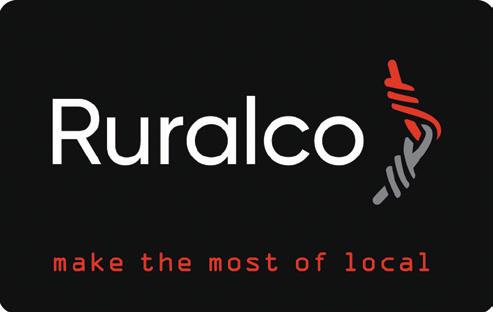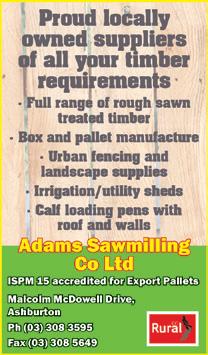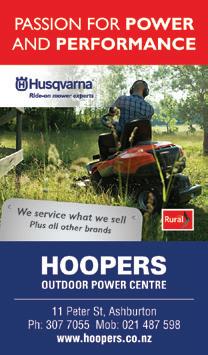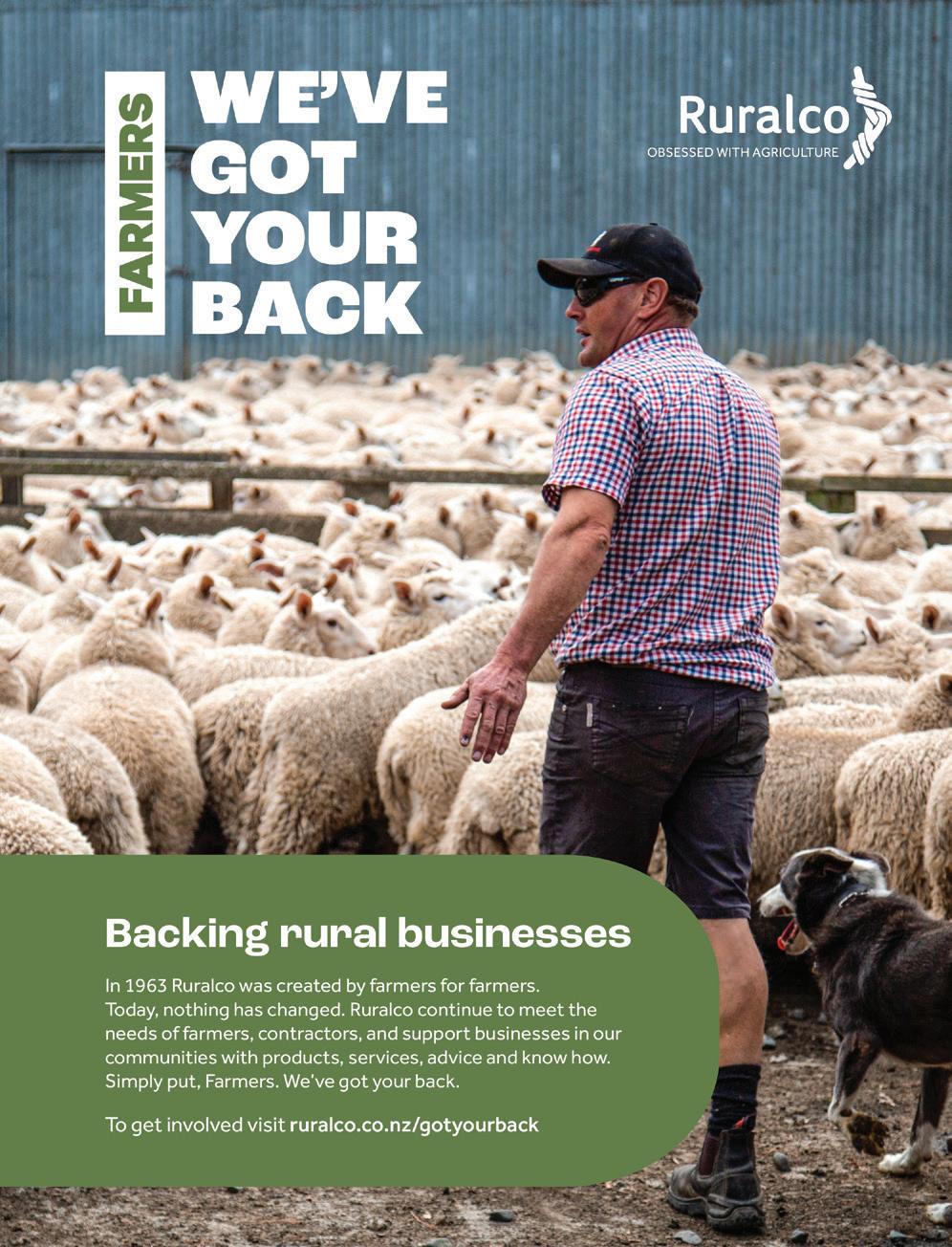From paddock to loaf
Catchment collective a boost to farm environment efforts
Ruralco appoints new Chair
Rhea Booker joins Board as new farmer representative


Catchment collective a boost to farm environment efforts
Ruralco appoints new Chair
Rhea Booker joins Board as new farmer representative

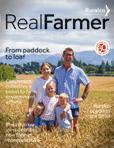
What a start to the year it has been. We hope that those who have been affected by the recent weather conditions and late harvest are now able to look forward to a more settled autumn.
While the days are still long and the temperatures mild, it’s the perfect time to get together with friends and family, enjoy a cuppa along with the stories and successes shared within this edition of Real Farmer.
We bring you the triumphs, trials, and tribulations from folk across the country who, like us, share a passion for agriculture.
We break bread with Canterbury farmer Marty Skurr, the man behind Minchins Milling, and learn about his experience with designating land, time, and money to tackle the niche market of homegrown, stoneground flour.
We meet our new Chair, Sir David Carter, who brings a passion for farming and wealth of chairing experience to Ruralco’s Board. In this issue we learn more about his Banks Peninsula-based stock breeding and fattening operation and get to hear his thoughts on the future of farming and agricultural importance in New Zealand.
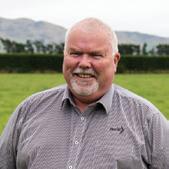
We take a look at Mid Canterbury’s Catchment Collective and explore how a collaborative voice will help with strategic planning and management of environmental and biodiversity initiatives brought forward by local groups. Read these stories, alongside many others, in this edition of Real Farmer. Looking forward we are excited to be celebrating our 60th year of business, and 60 years of supporting farmers for a brighter farming future. Keep an eye out for news on our anniversary celebrations happening later this year.
In March we will be attending the biennial South Island Agricultural Field Days at Kirwee and we look forward to seeing many new and familiar faces at the Mayfield and Methven A&P Shows, also in March.
RURALCO PO Box 433, Ashburton 7740 0800 787 256 www.ruralco.co.nz
EDITORIAL ENQUIRIES: Our team welcome your contributions, enquiries and letters. Please email to: marketing@ruralco.co.nz
ADVERTISING ENQUIRIES: Please contact the Marketing Department on: Tel: 0800 787 256 marketing@ruralco.co.nz
DISCLAIMER: Views expressed by contributors are not necessarily those of Ruralco.
Anita Body
Richard Rennie

Indiana Roberts
Annie Studholme
PHOTOGRAPHERS
Bill Cabout Annie Studholme
TECHNICAL ARTICLES
Agricom Tel 0800 183 358 info@agricom.co.nz www.agricom.co.nz
Ballance Agri-Nutrients
Tel 0800 787 256 ruralco@ruralco.co.nz www.ruralco.co.nz
Beef + Lamb Tel 0800 233 352 enquiries@beeflambnz.com www.beeflambnz.com
DairyNZ Tel 0800 4 324 7969 info@dairynz.co.nz www.dairynz.co.nz
FAR Tel 03 3455783 far@far.org.nz www.far.org.nz
FMG Tel 0800 366 466 www.fmg.co.nz
Hort NZ Tel 0508 467 869 info@hortnz.co.nz www.hortnz.co.nz
NZ Pork Tel 0800 697 675 info@pork.co.nz www.nzpork.co.nz
Rural Contractors Tel 0800 424 266 office@ruralcontractors.org.nz www.ruralcontractors.org.nz
Rob Sharkie robert.sharkie@ruralco.co.nzON THE COVER:
Sheffield cropping farmers Marty and Georgina Skurr’s venture into homegrown stone ground flour is about to hit a whole new level with a new mill about to come on stream
2 From paddock to loaf
8 Catchment collective a boost to farm environment efforts

14 Rhea Booker joins Board as new farmer representative

19 Ruralco appoints new Chair
23 Canterbury farmers claim top prize at Environment Awards
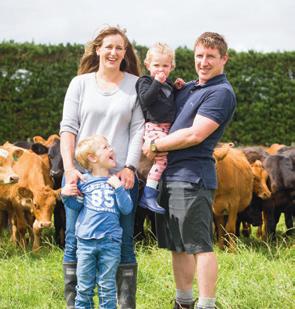
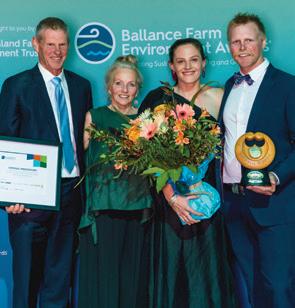
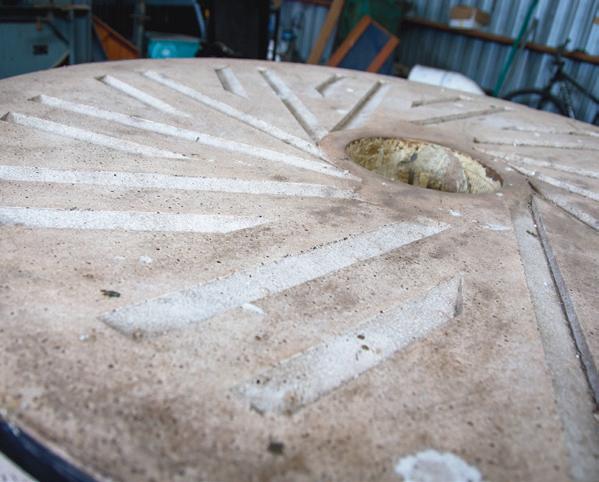
26 Primary sector set for strong second half
32 Recognition for rural businesses
29 Agricom forage oats for catch cropping post winter feed
36 Tight team behind cropping success
39 Magnesium’s effect on winter wheat
50 Good soil is good business
51 Cover crops drive faster soil organic matter gains
53 Knowing your numbers is key for the future
55 We do need education but not a brick wall
59 House fire prevention with FMG
63 Setting up ewes for mating
67 Food security in the land of plenty— or egg on our faces
69 Piggery and cropping operations pay off
40 Reshaping autumn
56 How to be smoke-free
57 Meet Raewyn Maw
57 Raewyn’s Recipe
58 Realistic emergency training adds value to all
It’s been a long, hard, slow grind, but buoyed by customer feedback, Sheffield cropping farmers Marty and Georgina Skurr’s venture into homegrown stone ground flour is about to hit a whole new level with a new mill about to come on stream.
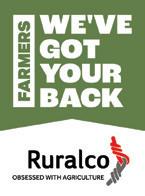
WORDS AND IMAGES BY ANNIE STUDHOLME
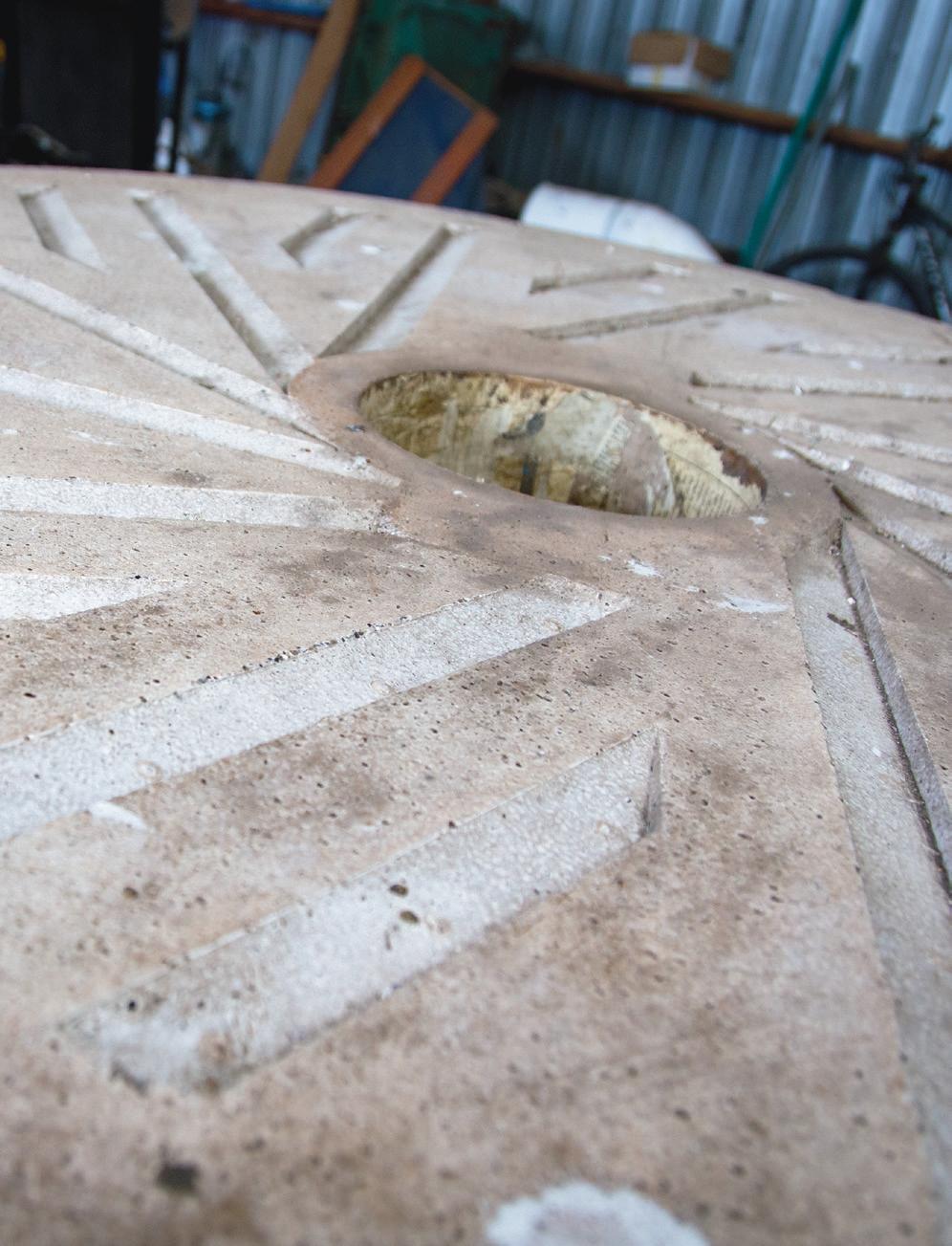
Marty Skurr is no ordinary cropping farmer. Intent on connecting with consumers directly, showing them why things are done on-farm and giving them a better understanding of where their food comes from, combined with a passion for growing great grain, he’s gone out on a limb, setting up his own stone ground flour mill. Having started small, testing the waters with a mill imported from Austria, Minchins Milling is weeks away from taking the business to the next level. They have invested heavily in time and money to custom-design and custom-build a new large-scale stone ground mill capable of significantly increasing production.
“It’s really exciting. People that use the product love it,” says Marty. “The first mill proved the concept but was terribly inefficient on time. The demand for the product was there, but we needed scale to make it viable. It’s a passion for me, but you have to be sensible. It still has to make money.”
Branching into milling is just the next step in the history of Riverview Farm. One Marty hopes will create even more opportunities in the future.
For nearly a century, the Skurr family have farmed on the south bank of the Waimakariri River. Marty is the fourth generation on the land. He had always intended to go farming. After finishing school, he went to Lincoln University, where he completed a Diploma of Agriculture and Farm Management before working locally and overseas, returning to the farm full-time in 2013. Though the farm’s deep, heavy silt-terraced country was good cropping land, growing dryland wheat and barley wasn’t without risks, given its potential exposure to drying nor’westers. The shift to irrigation with water through the Central Plains Water (CPW) scheme allowed the Skurrs to scale up their cropping business by adding three centre-pivot irrigators. They grow various crops on the 198-hectare home block, including ryegrass, wheat, clover, radish, hybrid carrot seed, and process peas, along with running about 2500 store lambs.
Marty was putting in between 40-60 hectares of wheat annually. Keen to find a way of adding value, he began looking at alternative crops. About seven years ago, a serendipitous encounter with internationally renowned craft baker Dan Cruden got him thinking. At the time, Dan was working as the head baker for Amano in Auckland’s Britomart complex, one of the few bakeries in the country to have its own onsite flour mill. They remained in touch.
“When you grow something like milling wheat, it’s harvested, put into a truck, then on-sold and disappears so that it could end up in someone’s flour in bread in Christchurch or somewhere overseas; we don’t know. There are so many rules and regulations placed on farmers these
ABOVE: Georgina & Marty Skurr with their children Phoebe, Hazel & Ted
BELOW: Stone grinding preserves the germ, the most nutritious and savory part of the grain
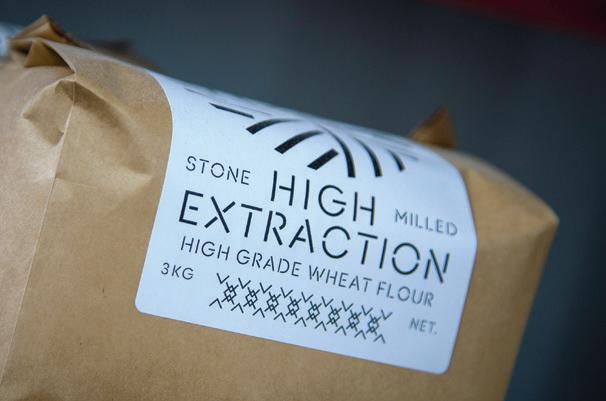
OPPOSITE: The mill stone for the new mill which is about to come on stream
days that I wanted something that I could turn into a positive.”
Marty started playing around with speciality grains. He first attempted cultivating spelt, a grain that dates back to 5000 BC, closely linked to wheat, but under their farming system, it proved a lot of work for less than favourable results.
Following consideration and discussions with Dan, who had left Amano to set up the famed The Real Bread Project in Helensville, Marty decided the future was in milling their own wheat. So the two banded together and came to an arrangement whereby Marty would supply a mill and a consistent grain supply to Dan. The original plan was to import about a dozen mills, put them in small to medium bakeries, and have a grain agreement back to Riverview Farm, but a few issues with the mill in Auckland highlighted problems in their plan. “I realised it was probably easier to do it at home with much more control of the whole process,” says Marty.
Marty installed the new mill in a fitted-out shipping container in the corner of an existing grain shed to keep costs down. But with a young family and a busy farm to run, it sat idle for many months until the first Covid-19 lockdown forced his hand.

As the nation scrambled to buy flour, Marty realised it was a case of now or never.
“Lockdown was the kick in the pants we needed to get it up and running,” he says. “We thought,
crikey, we have to do something. We always had a website, but it gave us the impetus to start pushing the online site.”
Luckily, they had a friend who was an IT whizz that could do the work, and within days, people could buy Minchins Milling’s products. Sales took off, and before long, wholesalers, bakers and home cooks sang their stone-ground flour praises up and down the country.
Marty explains that stone ground milling is nothing new; it has been around for centuries. Its slow, delicate process and higher extraction rate mean more of the wheat’s essential nutrients are retained in the flour.
“It’s quite different to bake with as it’s not as refined. I haven’t had it tested, but theoretically,
it will have more nutritional value because it contains more [wheat]germ, endosperm and bran and is higher in natural fats and oils. It means the consumer is getting all the benefits of the other portions of grain which are usually taken out while retaining its depth of flavour.”
The stone mills used today aren’t all that different from their historical counterparts. The only actual distinction is that modern stones are composed of a carefully manufactured composite material that requires less upkeep and is propelled by electricity rather than water, wind, or animal force. The ‘Osttiroler’ stone mill he started using was built by a family company that has been in the business for 80 years. Sadly, its capacity was as old-world as its technology, meaning it could only process 40–70 kilograms per hour, depending on the product. While it produced a quality product, it proved labour-intensive and highly inefficient.
Marty initially devoted one day a week to milling while processing wholesale orders in the evenings. Still, as the business grew, the mill started eating away at more of his time, putting a strain on other facets of their business. He soon realised the only way to make it costeffective was to get a much bigger mill.

“It’s all been through word of mouth and social media. It’s incredible where our business comes from and where our flour ends up. When we started, the basic business plan was for 50/50 retail to wholesale, but it ended up being about 80 per cent direct to business because of the volume. It’s not for every bakery, but it’s given us the confidence that there’s enough of a market out there to give it a crack.”
Marty credits Dan Cruden for really putting them on the map. Dan makes products (at The Real Bread Project) from stone ground flour using Riverview Farm-grown wheat and also supplies other bakeries.
“Those early customers (like Dan) have been key to our success. More and more people seem to be interested in the providence of their food. The bakers are committed to selling the story. We wouldn’t be where we are today without those people. We’ve had some wonderful feedback from people using the product. It’s so rewarding to get an email from someone saying how much they love it. That’s what keeps you going.”
Marty says unlike animal products which are more expensive to market, they’re fortunate their products are shelf-stable and can be stored for a long time. They also have less lowvalue by-products to deal with.
But taking the next step has been challenging. “The hardest thing has been getting help and advice. It’s a bit of a guarded industry. It’s not as though you can go out and buy a stone ground mill of this size. It involved talking to a lot of people.”
In 2021, he attended the UK Grain Lab, an annual meeting of bakers, millers, grain growers and scientists to advance an alternative grain economy in the UK. Marty found the contacts he made there invaluable.
On his return, Marty set about trying to buy the individual components to build their stone mill from scratch, presenting various challenges. “Just trying to find everything; it’s been a slow grind. Everything has taken time. It’s either custom-made or custom-designed. None of it is just run-of-the-mill stuff.”
Marty had initially hoped to have the new mill operational before the end of last year, but the project had suffered one hold-up after another. He explains that the mill stones themselves had taken over a year to arrive from when he ordered and paid for them until they finally showed up last November.
Having initially set up Minchins Milling within the farming business, it is now set up under its own umbrella. He has also brought in some industry leaders to assist with helping make decisions and some guidance.
The mill is only one half of the Minchins Milling success story, though. The other is the grain produced on Riverview Farm.
While he is not interested in going organic, Marty remains committed to doing everything possible to benefit the environment while reducing their footprint. They use sustainable farming practices whether it’s nutrient budgets, GPS guidance, centre pivot irrigation, soil mapping and testing, incorporating crop residues, soil moisture monitoring probes, Farm Environment Plans, direct drilling, cover crops or biodiversity plantings. The farm is also home to a 2-hectare native wetland and other natural native areas which have been looked after for four generations, and that will continue.
Marty says they’re always refining their farming methods. Every operation is assessed to get the right tool for the job. They find the most sensible way to use their land to yield the highest quality crops whilst looking after the soil. Having a diverse crop rotation involving cereals, grasses, legumes and livestock are key to keeping the soil nourished and balanced. By keeping up with progressive farming practices and technology, he says it allows them to reinvest into the farm business to increase efficiency, resilience and biodiversity while enhancing the quality of their grain. They closely monitor each crop for weather and disease. Where possible, they use diseaseresistant varieties and delay planting, as less time in the ground means less time for a disease to strike. Most of the milling varieties they use come from the New Zealand Institute for Plant and Food Research, all part of the story of using Kiwi tried and tested, says Marty. The first time he tried ‘spray free,’ it was a success. The 12 hectares had been in lucerne for three years, so it was able to produce a
9-t/ha crop without urea and only had a preemergent herbicide applied. But he tried it again the following year, and it was terrible.
“It’s common-sense stuff,” says Marty. “You have to be flexible. We try not to rely on chemicals for everything. Where we can reduce it, we do. But if the crop looks like it needs a hand or we are in a bad weather system, we spray if we have to. There is too much at stake if we don’t put it on. You don’t want to back
in the future, Marty says they will have to look at buying wheat from other farms with similar values. He has only talked to farmers at this stage, but they may look at having contracts in due course. “We just don’t have the scale at the moment.”
Since launching Minchins Milling, Marty admits he’s been spreading himself pretty thin trying to do everything from farming to physical milling and all the sales and administration. It’s
yourself into a corner and say it’s ‘spray-free’ and then not have anything to sell. You do the best with what you have got.
“At the end of the day, our responsibility is to produce good food. It would be irresponsible for us to go organic and have nothing to feed the people.”
Marty enjoys explaining to people, especially bakers, the reasons behind what they do on-farm. “Most have absolutely no idea. I get a lot of satisfaction from telling people what we are doing. Otherwise, they tend to make assumptions. They think we are all eco-terrorists that spray glyphosate on for the sake of it.”
Marty says their wheat quality is almost like a time capsule of what has happened in the paddock for that growing season. There will always be seasonal differences. “It may perform differently with each season, but I can let people know that. That’s the beauty of having a single origin. I know exactly which paddock it has come out of, and I am in direct contact with our consumers.”
Unlike conventional flour that has to be less than 15 per cent moisture, their flour can also be slightly dryer than standard flour as unless it requires drying, it’s precisely at what it comes off the harvester.
At Riverview Farm, they aim to keep 12 months of grain on hand to safeguard their product in case of an adverse weather event. But in a bid to de-risk their business as demand increases
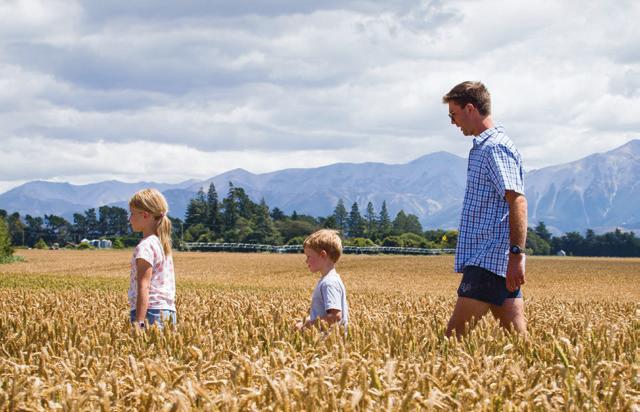
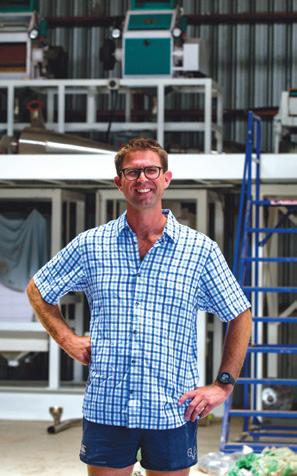
ABOVE: From grain to flour—the Skurr’s manage everything through sowing, growing, harvesting and milling
BELOW LEFT: Marty in front of the new customdesigned and custom-built large-scale stone ground mill capable of significantly increasing production
been tough, especially with a young family. He’s even pulled Georgina in to help with packaging. In the future, he’s realised some decisions need to be made.
“It just comes back to scale to justify having people to do all these other jobs like marketing and Facebook while still keeping it as lean as possible. We have been constrained by time and money. I’m still undecided whether I get someone to run the farm or manage the mill [in the future]. I’m not afraid of bringing in contractors on the farm. You ring someone up, and it’s done.”
While it’s been backbreaking work to get it to this point, Marty says he’s finally excited to take that next step. “I could have bought a lot of nice machinery [for that money], but I didn’t want to die wondering. You are only young once. I saw an opportunity, and we have implemented all the systems to make it happen. We are pretty committed now. It’s been pretty stressful but really enjoyable at the same time. Long-term, hopefully the financial rewards will come.”

On 21st August 1963, the Ashburton Trading Society
Sixty years later, the co-operative continues to grow,

Placing catchment communities in the Ashburton District at the centre of decisions and direction on biodiversity, water quality and the environment is now possible thanks to the Mid Canterbury Catchment Collective (MCCC). Formed just over a year ago, the collective promises to deliver greater horsepower and strategic direction for the multiple and diverse catchment groups that have formed in the region over the past decade.
WORDS BY RICHARD RENNIE, IMAGES SUPPLIEDCollective co-ordinator Angela Cushnie is part of a high performing team supporting catchment groups to start-up and plan their goals. Alongside the MCCC committee, made up of farmers, rural professionals and catchment group members, Angela works with a team of facilitators to leverage the many talents contained within Mid Canterbury.
“What we are aiming for is to help groups avoid re-inventing the wheel when it comes to specific catchment projects and monitoring programmes members may wish to initiate. That may include having a template we circulate for water monitoring projects, or biodiversity enhancement. It means as a collective we can get far more strategic about who is doing what,
for what purpose, and ensure we are all working collaboratively,” says Angela.
Nationally community-led catchment groups have started to get the ear of government, with ministers taking greater notice of the initiatives they have started, and acknowledging the role the groups can play in helping central government improve outcomes around the likes of biodiversity, water quality and healthy soils and nutrient loss mitigation.
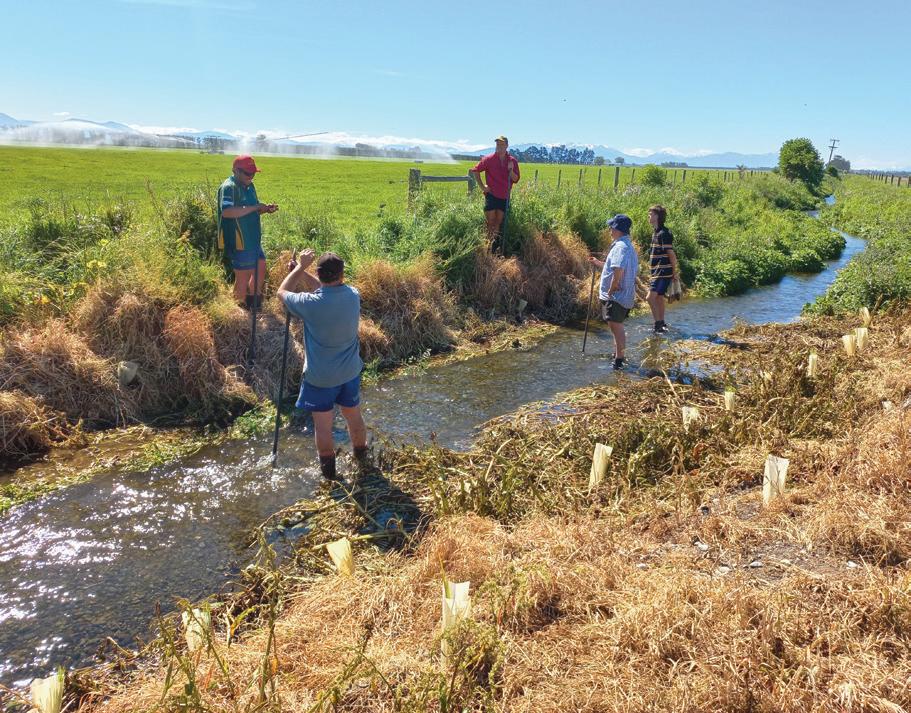
Last year saw Agriculture Minister Damien O’Connor acknowledging groups, with

the investment of $610,000 over three years into the Hakataramea Sustainability Collective in the Hakataramea Valley. This came on top of the $8.4 million already allocated to support catchment groups and Rural Community Hubs across the wider Canterbury region by government. To date there have been investments in over 170 farmer-led catchment groups around New Zealand with the support of Ministry for Primary Industry, DairyNZ, Beef and Lamb and Foundation for Arable Research.
MCCC’s boundaries extend from the mountains to the sea, between the Rangitata and Rakaia rivers, containing some of the country’s most diverse land uses, soil types and environmental challenges. The vision is that approximately 14 individual catchment groups will be captured under the collective’s umbrella but early days still as MCCC focus on creating an approach that is enduring, intergenerational and sustainable.
“For example, in the lowlands Hinds district there can be a sense we are the canaries in the coal mine for actions further upstream where freshwater springs and tributaries contribute into the Hinds River. Under MCCC we can co-operatively work on solutions, determining how we are going to approach the problems.”
“This type of approach rather than finger pointing, blaming and only seeing the problems, puts communities and people at the centre of a solution-focused journey which is where meaningful change happens.”
Angela said she had been struck at the disconnect and lack of collaboration between much of the research being done on farm environmental challenges and those at the coal face. Under a collective umbrella it will become possible to commission and guide research focused on farm and catchment solutions specific to the catchments those problems present themselves in.
She has been particularly struck by the success the longer established Thriving Southland catchment group has enjoyed, with well-founded scientific approaches helping underpin a better relationship between researchers and farmers seeking solutions.


“I have to admit to being super jealous of what they have achieved working with Dr Clint Rissman, founder of research group Land and Water Science. His work has focused on using the science of physical geography, known as physio-graphics to evaluate and determine water quality in catchments. As a practice it has done much to combine the oftensiloed disciplines of soil, geology, hydrology and biochemistry (see article on Thriving Southland).”
Often the knowledge imparted by scientific experts when done properly can do much to unlock aspects of land management farmers may well have had for some time, but simply
had not had the science to ground truth and support their beliefs.
“If they can be told the ‘why’ behind it, it helps add value to that science, and motivate a change in approach with greater understanding of why certain outcomes are important.”
She says future research projects proposed by the collective will take a ‘pragmatic’ approach, with some groups more focused upon establishing water quality monitoring programmes while others will be aiming for a better understanding of soil health, hydrology and aquifers, for example.
While much of the central government’s regulations around water quality, biodiversity and soon greenhouse gases have been captured in policy settings, Angela says a strong collective will have the ability to positively influence the pace of change.
“I think most groups from across communities tend to want the same thing, improved
environmental outcomes, and broadly agree with the direction of travel—it’s important we can have an influence on the pace of the changes. With over a century of urban and rural modification of our landscape, there is no point in being told something has to be done in ten years when community catchments are questioning the feasibility, it’s just setting people up to fail.”
Angela is encouraged by what she sees as a less combative approach between community groups about achieving environmental outcomes these days.
“I think by and large there is a genuine willingness to work together as we have realised we largely want the same outcomes. In some cases that will seem too slow, for others it’s coming too soon.”
BELOW: A biodiversity visit to Russell Langdons’s farm and wetland in the Lagmhor Westerfield catchment group
BOTTOM: Hekeao Hinds Hill Country catchment group wetland project
Further south, the Thriving Southland catchment collective may provide an invaluable guide to what Canterbury catchment groups could aspire to, and achieve, under their Mid Canterbury Catchment Collective initiative.
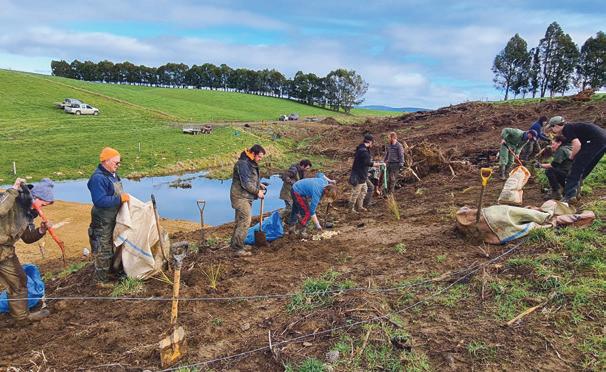
Thriving Southland was created with input from Ministry for Primary Industries’ productive and sustainable land use programme after the value of farmer catchment groups was acknowledged by Minister for Agriculture Damien O’Connor back in 2021.
Over $25 million has been invested in catchment groups by government since 2020, as their value in helping support farmers developing detailed farm environment plans was recognised.
Now in its third year of life, Thriving Southland has 33 individual catchment groups under its wing, accounting for about 85% of the region’s land area.
One of those catchment groups is Wendonside Catchment Group covering 27,000ha spanning from Dome Burn Creek and the Mataura River, down to the confluence of the Waikaia and Mataura rivers.

Wendonside group chair Rob Dingle says the catchment groups have always been driven from the ground up, manned by volunteer farmers keen to seek solutions to problems at a farm level. This was often at stark odds to central government plans that have attempted to bring a “top down” regulatory approach to environmental management. His own group has been going for almost four years and claims an exceptional 85% engagement by farmers in its zone.
“Thriving Southland has been good in that it has provided resources to manage the administration of catchment groups, something many trip over on because it is a lot of (voluntary) work involved by people also trying to run their farm businesses.”
With a team of staff resourced, they are able to help guide groups through the funding steps for projects, get projects going, and do a good job of informing all groups about what is going on across the entire region.”
Those communications also include regular updates via the Thriving Southland YouTube channel.
Rob says prior to Thriving Southland’s formation many catchment groups had some good ideas but did tend to be a “bit random” in execution.
“You had a situation where groups were forming and then floundering, some flew, and some did not. Thriving Southland put some structure around things. Today we have 33 catchment groups, compared to 15 a few years ago.”
A level of accountability for success or otherwise of projects is also provided by Thriving Southland’s ties to MPI.
He maintains the $4 million invested in the group is not a great deal in context of what it can achieve across such a significant, productive agricultural region.
His own group has been participating in a cutting-edge farm mapping project working with Dr Clint Rissman whose company is Land and Water Science. The mapping project is providing granular, paddock level data on individual farms’ environmental impact through physiographic or multi-disciplinary scientific analysis and mapping.
“A lot of policy has been formed in the past on historic science, or with massive gaps in knowledge, possibly only using a few sampling sites to base that policy on.
“These are simply not accurate or bespoke enough to reflect individual farms’ characteristics and responses to environmental challenges, yet all farms can end up being effected by the same rule regardless.”
In the Wendonside catchment there are now 43 water sampling sites across the 30,000ha, providing far more detailed, relevant, and informed information to farmer members.
“And incidentally that water quality is generally very good.”
The information and individual farm maps Dr Rissman’s system can create means farmers are getting a “layer cake” picture of their farm, with more detailed breakdowns of physical properties and with that more relevant, specific solutions to help improve their farm’s environmental footprint. “This has also been helped by another project aided by Thriving Southland that has the soils being re-mapped, based on latest science rather than that done in the 60s and 70s.”
“On our farm for example a Mataura silt loam that was thought of as free draining has been reclassified, with quite different drainage qualities.” Having such proprietary information paid for by Thriving Southland and catchment members has empowered farmers when it comes to discussions with regulators.
As farm environment plans become standard, tailored farm data ensures those plans will be precise and relevant, rather than devolving into a simple “one size fits all” box ticking exercise. Having dairy farmed in Mid Canterbury and being very familiar with its particular challenges, Rob is confident the Thriving Southland model is a very transferable template for MCCC.
“You only get engagement from farmers when they are recognised as holding the answers, and you have to provide them with robust data that is relevant to them, not just to their district or region.”
Five years ago, the Wendonside group was formed to “fight tooth and nail” for their farming viability amid new regulations.
“We were very much ‘gloves on’. We are now in a position of ‘gloves off’. We have the funds and the data and in fact have the council coming to us, keen to see the data. We are at the table helping design and determine regulations.”
The Mid Canterbury Catchment Collective (MCCC) has kicked off with some ground-breaking projects already well underway to provide resources and knowledge for the collective’s members to draw from.
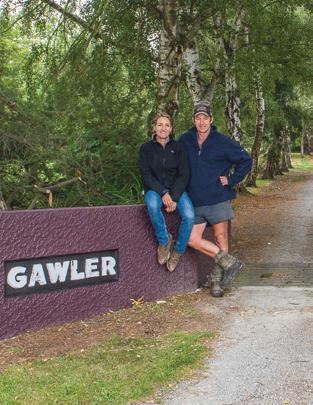
The Hekeao Hinds Hill Country catchment group has a wetland project already well established on co-chair Nick France’s property near Mount Somers.
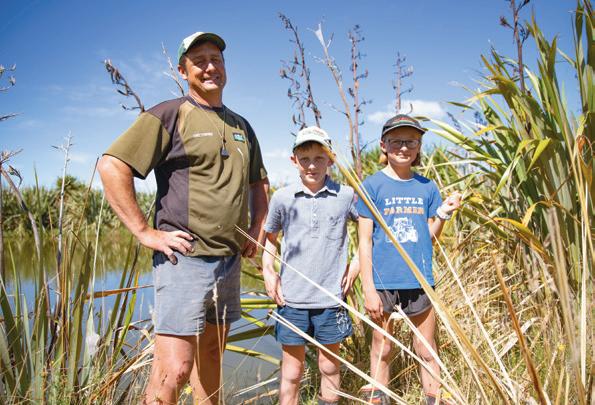
With 18ha of native wetland species already planted, Nick says the project is helping highlight how wetland restoration and protection is a “quality not quantity” journey, one that takes time, money, and many hours of labour input.
“We would have spent thousands of hours on clearing and planting, with about 6000 natives that have been selected scientifically on the basis they are best suited to this location. It is an intensive process, it’s not cheap, and requires total commitment.”
He said belonging to the MCCC means his catchment group will get greater leverage by pooling resources and knowledge, and hopefully a louder voice when working with local council and government.
Fellow catchment group co-chair Harley Davies has been engaged in an aquifer recharge project on his 1187ha property, and is another catchment project drawing strong farmer, government, and council interest in its outcomes.
Harley and Neroli’s Gawler Downs farm is the site of a near river recharge (NRR) project. This essentially provides a clean water top up to a target river system when flows are low. Other trials also include managed aquifer recharge sites on the Plains using clean surface water trickling into groundwater to help clean the ground water and spring system connected to it.
The work on the Davies’ property also includes wetland reconstruction and planting about 10,000 native plants. Water quality, river flow, ground water level and fish populations have all shown improvements over the last four years.
Phill Everest who, along with his son Paul, was the recipient of the esteemed Gordon Stevenson Trophy for the 2022 Ballance Farm Environment Awards farms in the Hinds catchment and welcomes the MCCC’s formation.
“The key for us is it means we can all work collaboratively. It can be hard for small catchment groups to know what is going on above and below their area, and hard to make changes if what is happening above you in the catchment is not changing too.”
“It is all about us collectively putting our time, energy and money into it as a community, to learn and share what we do and to ensure we don’t all make the same mistakes.”
BELOW


New to the Ruralco Board is chartered accountant and farmer Rhea Booker. Originally hailing from Waikato, Rhea’s parents came to New Zealand as immigrants, working their way up the dairy industry ladder from farm workers to farm ownership while raising their six children.
WORDS BY ANNIE STUDHOLMEAfter leaving school, she attended the University of Waikato, completing a degree in Management Studies, majoring in accounting. Having inherited her parent’s passion for agriculture, Rhea started as a student accountant for Fonterra working at the Hautapu factory in the manufacturing team. It was here that Rhea realised she could utilise both her passions for agriculture and accounting.
“I don’t enjoy tax or auditing,” she says. “I like to be involved in the nuts and bolts of a business, trying to run a smoother engine and improve
performance. My skillset is management accounting which is more hands on as opposed to financial accounting. It’s about looking forward and improving the drivers of performance.”
After leaving Fonterra, Rhea worked for the packaging company Pact Group Limited before heading off on her OE. On her return, she worked as part of Beef + Lamb New Zealand’s Economic Service, first in Northland and then in Canterbury and Otago.
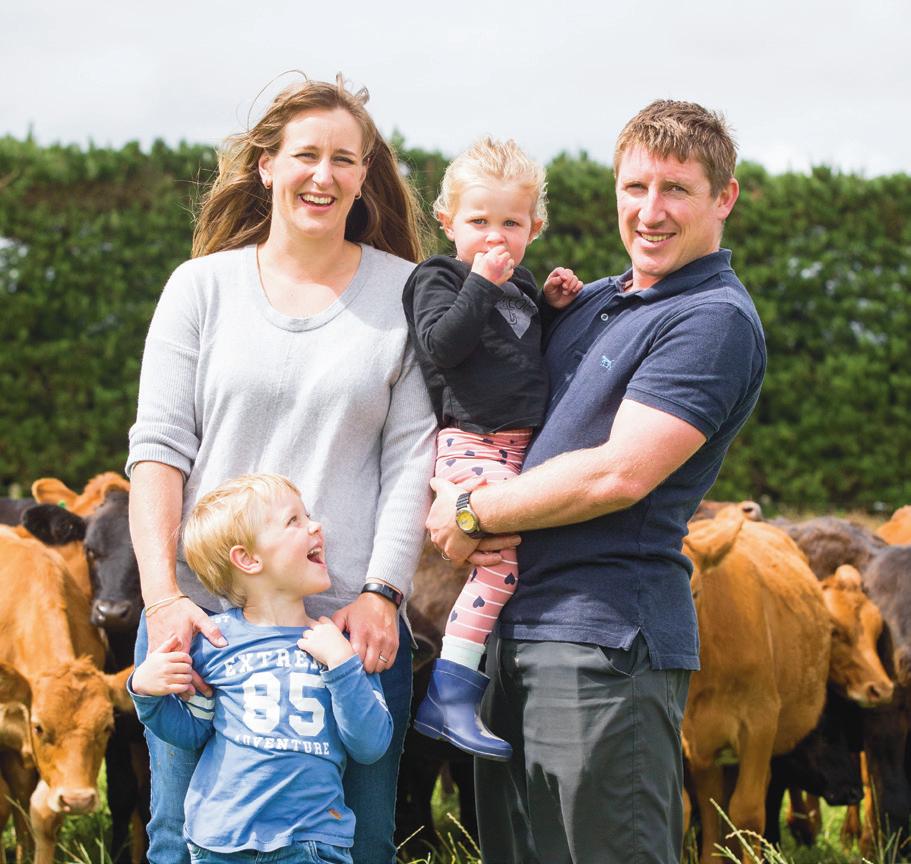
Formed back in the 1950s, the Economic Service surveys farms throughout New Zealand to provide a sound base for forecasts of meat and wool production and trends in the sector by linking physical production together with financial returns and the capital structure of farms. It produces the sheep and beef mid-season update in February, and in September each year, it publishes its estimate of the actual farm situation for the new season ahead.
“What I loved about the role was being able to work directly with farmers and learning more about the sheep and beef industry and their challenges,” says Rhea.
Attracted by the large-scale farming operations, she and husband, James Booker, decided to move to Canterbury in 2015. Rhea initially continued her job with Beef + Lamb NZ. Later she took on the role as Management Accountant for Ashburton-based Midlands Apiaries Limited and new start-up, Kaipak Limited. Rhea then moved into a Systems Accountant role for the Midlands Group focused on improving systems, both process and IT, in order that the whole business could get greater efficiency and value from its technology investment and process design.
“I first try to get the best out of the systems they already have in place, and if it isn’t going to meet the needs of the business, introduce new ones,” explains Rhea. Essentially, the goal posts are to generate reliable and accurate information so staff, management and board can make informed decisions. A significant portion of her work has been self-driven, guiding the business owners and stakeholders in understanding business capability and delivering on goals.
Once they started having a family, Rhea became self-employed, initially contracting back to Midlands Holdings. They welcomed their son William (now 4) in 2018, followed by Adalene (now 2) in 2020.
She now splits her time between raising their two children, contracting to Ashburton Contracting Limited, improving their systems, quality of information and reporting, and contracting to Rural Business Accountants. She is also treasurer of the Methven Care Trust and Methven Preschool. Both are voluntary positions. James is currently the Canterbury Regional Manager for Southern Pastures, based outside Rakaia, a business where he oversees operations across nine dairy farms.
Together with Rhea, they are part-owners in Maatua Hou, a calf-rearing business set on a 34ha irrigated block near Burnham.
Maatua Hou (which means new parents) is the brainchild of four young couples with children working together to reduce the number of bobby calves in the industry and provide quality dairy beef calves to the beef industry. Together they have formed an equity partnership, bought a block of land, and found a group of farmers willing to supply them with calves that would have otherwise been destined for the bobby truck, entering into a profit-share agreement.
Unlike traditional calf-rearing operations where the owner buys the calf outright, at Maatua Hou the suppliers retain ownership of the calves and share in the rearing expenses. “It’s a win-win,” says Rhea.
“For us, it means we don’t have to buy calves, it reduces risk and the burden of overall costs leading to a more stable business. Whereas, for dairy farmers, it offers them a viable alternative to putting bobby calves on the truck at four days old.” Maatua Hou acts as the middle ground for the growing stage of the calves’ lives before returning them to be finished or sold at over 100kg.
Maatua Hou’s calves come from heifers in their first mating and early calving mixed-age cows that dairy farmers don’t need replacement calves from. The calves arrive, on average, at seven to eight days old, meaning they can remain on whole milk for longer after the initial colostrum feed. The owners go to the farms to check out their health. They pick them up on trailers, 30 to 40 at a time, themselves to ensure their travel times are reduced and drop them directly into their pens to minimise stress. Once they arrive on-farm, calves are fed once a day, with a weight-gain target of around 600g per day with this increasing as they get older.
Maatua Hou’s continual appetite for innovation was rewarded by picking up last year’s Innovative Farming silverware at the Beef + Lamb New Zealand Awards.
Admittedly though, there was still much to learn, says Rhea. Initially, they started out rearing 600 calves, but this season they’ve reduced it to 200. It’s about doing fewer calves and doing them better in a bid to establish the right staff-to-calf ratio and cashflow per calf. Going forward, they intend to duplicate this
year’s successful model with smaller numbers and increase that to 600 calves.
“We firmly believe there will come a time where the scale of the current bobby calf sector will contract as both milk and meat processors deal with consumer pressures; we want to be part of the solution,” says Rhea.

While she appreciates a lot of regulations are being placed on farmers now, she says it’s crucial not to get caught up in the negative. “Farming has always had challenges…. just look at the 1980s. Farmers adapt, play to their strengths and carry on. The industry is filled with amazing people, and when you have great people, you can achieve great things.”
Rhea says she is excited about putting her skills to use as part of the Ruralco Board. “I love business, and if I can align that with agriculture, brilliant. Ruralco has an amazing culture; it is something you can’t script, you can’t get it out of a book; you either have it or you don’t, and I am proud to be a part of the Ruralco team”
She believes her practical business operations experience, including that in performance reporting, project management, and introducing new technologies puts her in good stead to add value. “This is an amazing opportunity for me; I am surrounded by great minds. I’d like to think that my skillset coming from the other side of the board table and being in the engine room will be of benefit, and I look forward to contributing my experience to the board.”
OPPOSITE: Rhea and husband James Booker with children William and Adalene
BELOW: Maatua Hou (which means new parents) is the brainchild of four young couples with children working together to reduce the number of bobby calves in the industry and provide quality dairy beef calves to the beef industry

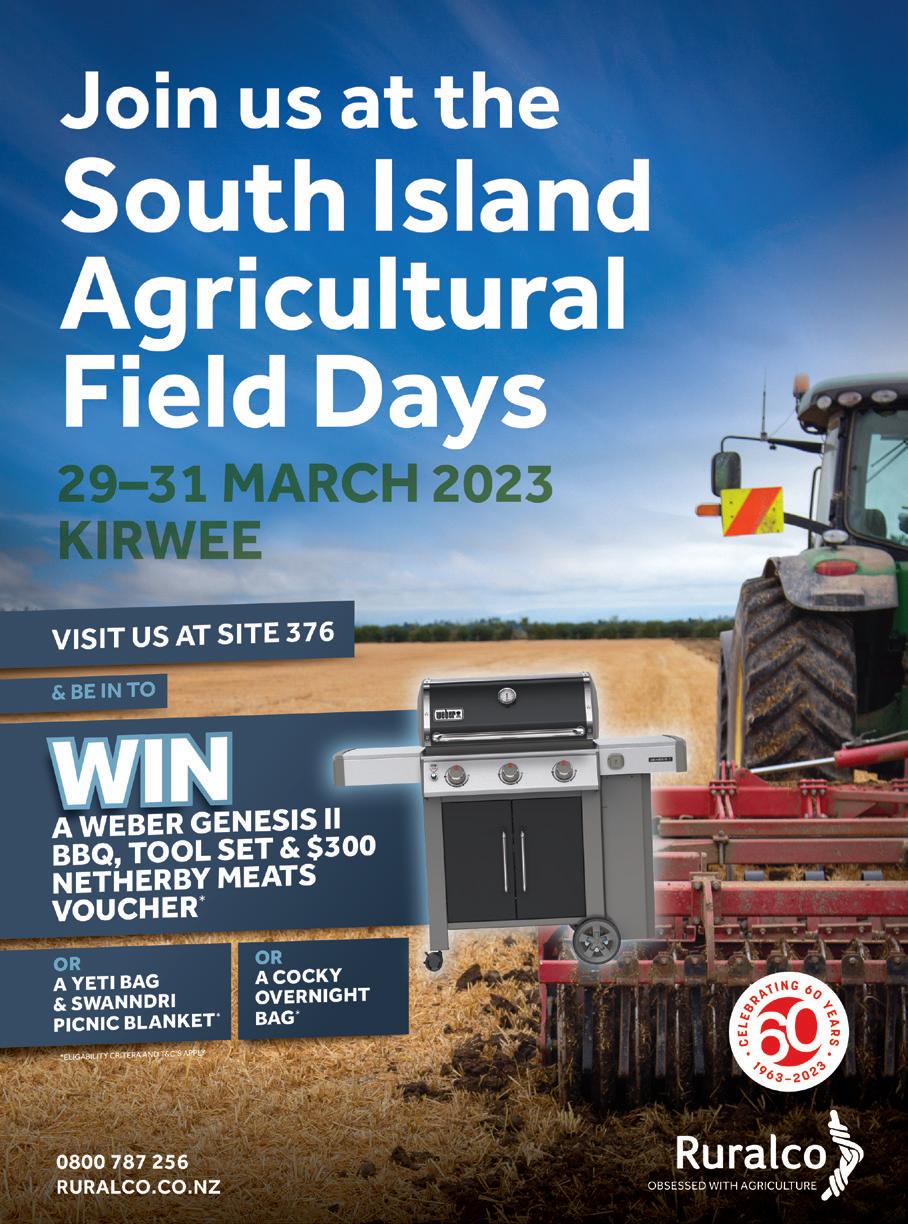

Knowledge, experience, and passion for agriculture are key drivers behind new Ruralco Chair Sir David Carter.
After serving on the Ruralco board since 2020, Banks Peninsula farmer and former politician Sir David Carter has taken over the Chair’s reins following previous Chair and Director Jessie Chan’s decision to stand down at November’s Annual General Meeting.

David brings a wealth of knowledge to his new role, with a passion and long-term commitment to agriculture. “I am honoured to be appointed by the Board to the Chair role. I am committed to supporting our CEO and Executive team to continue the good work done to date by all our people and to keep challenging ourselves to deliver value for our members,” says Sir David Carter.
Though city-born and bred, David developed a passion for farming during his teens. After studying at St Bede’s College, he completed a Bachelor of Agricultural Science at Lincoln University, graduating in 1973.
After Lincoln, armed with a loan from his father and vendor finance, he started farming at West Melton, establishing New Zealand’s first commercial embryo transplant company to help introduce “exotic” cattle breeds down under. At the time, bio-security risks prevented European cattle breeds from being imported directly into Australia and New Zealand. Still, if the stock had been isolated in the UK for one generation, then the progeny could be imported. Through this project, David established the highly regarded Avon Park Simmental Stud.
With dreams of farming on Banks Peninsula, David later sold the property at West Melton, buying, selling, and developing a couple of blocks before settling at Manor Farm in Teddington in 1985. During this time, he met Heather, who was then working as an international flight attendant for Air New Zealand. They married and had four children - Sophie, Laura, Isabella, and Morgan. The 1980s were tough for farmers still suffering from the lasting effects of Rogernomics and the removal of subsidies. Farmers were moving off the land in their droves. David saw a need for farmers to have political advocacy at a government level, and with Heather’s support, he decided to launch his political career.
Though he missed out on securing the long-held left Lyttelton seat at his first attempt, he won the Selwyn by-election the following year after Ruth Richardson stepped down. David’s maiden speech to Parliament was on 30 August 1994. From the outset, he advocated for rural people and their communities, something that did not waver throughout his 26-year political career.
During this time, he chaired numerous select committees as a Member of Parliament before becoming a Senior Cabinet Minister from 2008 until 2012. This included being Minister of Agriculture, Biosecurity, Economic Development, Forestry, and Primary Industries from 2008 to 2012 before being elected Speaker of the New Zealand Parliament at the start of 2013. David decided to step away from politics in 2020. “After 26 years in politics, I know I’ve had my time,” he says. He singled out the Canterbury Plains Irrigation Scheme as an achievement he was very proud to be part of during his career. In December 2020, David was awarded a Knighthood recognising his 26 years of public service.
do it at a pace that is not only environmentally sustainable but financially as well.”
“To a young person looking to make a career in agriculture, I would say the future is bright. Farm ownership may not be as easy as it was, but there are many avenues to have a successful career in farming and be a caretaker of the land.”
David currently has substantial farming interests based at Banks Peninsula. They run a low-cost operation, preferring to do much of the work themselves, employing casual labour when required. Daughter Laura is currently doing all the day-to-day farm work, but David still enjoys getting out on-farm when time allows. He particularly enjoys the development phase.
Despite the anti-farming sentiment, David says the future of New Zealand agriculture is positive. “We have a world-class, grass-fed, outdoor, no-subsidies model. New Zealand is superefficient in agriculture, and not many counties can compete. I believe the challenges around coping with climate change and the environment will be solved with science and our research programmes. We’ll get the solutions in the next 50 years, but we’ve got to give science time.”
David firmly believes farmers want an opportunity to adapt to best practices. “Farmers agree with what needs to be done to protect our environment; they just want the chance to
Rob Sharkie, Group CEO Ruralco says the Ruralco Board looks forward to continuing to grow the business under his leadership. “David’s experience in governance and farming has been valuable during his Board tenure. With him now moving into the Chair role, we look forward to working together to build Ruralco into the partner of choice for rural New Zealand.”
OPPOSITE:





company Danone to test a mixed species pasture, as advocated by regenerative farming proponents, in yet another effort to add facts and evidence to environmental disputes.
As a Climate Change Ambassador for Dairy NZ, Phill has been actively trying to reduce greenhouse gas losses on-farm. Last year they reduced their nitrogen losses by more than 36 per cent from their baseline, meeting their 2035 loss target for the Hinds Catchment. They chose to reduce their nitrogen fertiliser application meeting the 190kg/hectare cap a year ahead of the Government deadline. Previously they had been using 230–240kg/hectare of N a year, depending on the season. “That decision cost us; we grew less grass, put more supplement in and produced less milk,” he says.
But it also taught them some valuable lessons. The focus from now on is on improving pasture growth with greater clover growth in an attempt to maintain milk production. Other changes included developing an annual nitrogen application plan and using a coated urea product which reduces greenhouse gases and nitrogen losses.
The Everest family of Flemington Farm has received one of New Zealand’s highest honours for their outstanding dedication to creating a sustainable dairy farm that combines the needs of people, animals, economics, and the environment.
WORDS BY ANNIE STUDHOLME, IMAGE SUPPLIED BY BALLANCE FARM ENVIRONMENT AWARDSFollowing on from their overall success in the 2022 regional Canterbury Ballance Farm Environment awards earlier in the year, the Everest family received the National Ambassador for Sustainable Farming and Growing award at the New Zealand Farm Environment Trust National Sustainability Showcase last November.

Driven by an unwavering passion for farming, Phill and Jos Everest, together with their son Paul and his partner Sarah, are leading the way in successfully reducing greenhouse gas emissions and Nitrogen losses on their 270-hectare dairy farm at Willowby.
Born in Methven, Phill graduated from Lincoln University with a Bachelor of Agriculture Science and became a respected farm consultant. Coming from the Waikato, Jos came from a farming family.
In the late 1980s, they sold their Ashburton home to buy a 130-hectare farm at Willowby. For the next 20 years, they leased the land to a cropping farmer and raised 100 bulls annually, leaving Phill to continue working full-time as a consultant. When a neighbouring farm came up for sale, they effectively doubled their area.
“I consulted my way into farming,” says Phill. From the outset, the Everests were committed to improving the environment, planting thousands of trees and shrubs covering more than 20km along drains and fence lines to enhance the quality of water and provide shelter for stock from mainly the southerlies in the spring.
When they converted to dairy in 2010, they remained committed to minimising the environmental impacts of their farming operation. They used the best technology of the day to establish their 225-hectare milking platform. Key considerations included having a grass-based system, having one person in the shed each milking, minimising water use and treating effluent as fertiliser.
Phill became an active member of both the Hinds Drainage Working Party and the Hekeao Hinds Lowlands Catchment Group, which, although a lot of work, had been rewarding for the community. He is also collaborating with Synlait, AgResearch, and multinational food
Plantain and chicory have also been added to their pasture mixes for over six years, and an extra 1kg of plantain is spread annually with capital fertiliser to help it persist. They also feed up to 5kg fodder beet during April and May. “Fodder beet is much lower in protein which equates to lower autumn nitrates,” says Phill. The Everests have also installed a variable rate irrigation system on one pivot, allowing water to be applied at different rates across a paddock, reducing draining and nutrient losses and keeping areas around troughs, lanes and gateways dry. They also have Aquaflex water monitoring under each pivot. No effluent is applied in the autumn, with the farm having enough storage to hold it through until the spring which again avoids the high winter leaching period.
Phill says that no one thing makes the difference; farmers needed to be trying a few of them. It’s about balancing your environmental aspirations with being a profitable business. “It’s a whole lot of small things, and cumulatively, they do add up.”
“There are lots of farmers out there trying hard to reduce environmental impacts,” Phill said. “We are trying to leave the property better tomorrow than it was today.”



With the farming year now over halfway through its season, many in the sector are enjoying some return to normalcy, or at least the “new normal” of a post-covid business environment.
WORDS BY RICHARD RENNIEOver covid the sector exhibited a remarkable ability to continue harvesting, processing, and
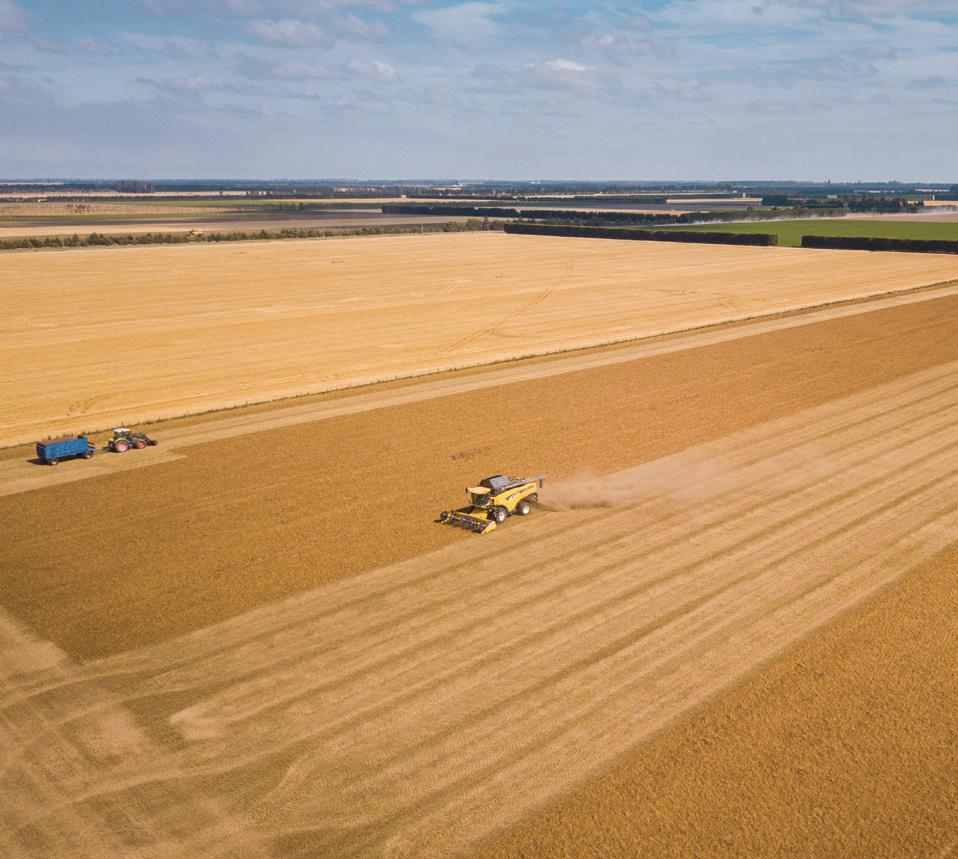
shipping high value food products, and is well positioned to leverage off the ever-increasing improvements in shipping and improved global supply chains.
Meantime the Ukraine war came hard on the heels of the world’s early stages of covid recovery, plunging markets into another state of volatility and uncertainty while also putting global food supplies in peril in a way covid never did.
The war appears to be entering a grinding stalemate, likely to extend through 2023 and possibly even the year after.
However, despite the continuing global tumult, predictions on New Zealand’s primary sector’s contribution through the coming year are highly positive, and were reinforced by the latest Situation Outlook for Primary Industries (SOPI) report released in early December.
Taken as the definitive guide by industry and policy makers on where the sector is heading, the December SOPI report paints a highly positive picture of where the sector is heading, and what farmers can expect returns’ wise in the coming months.
Expectations are the primary sector will experience a solid 4% year on year growth on the sector’s exports to the year end June, to enjoy about $55 billion of overseas earnings in a global market fraught with a high level of uncertainty and tension.
That forecast is a full $3 billion up on where the sector envisaged in the earlier six-month survey, with every sector enjoying positive growth sentiments.
The report predicts dairying will enjoy the biggest lift, with a full 6% increase in revenue
reaching a record breaking $23.3 billion in the year, and this comes despite milk volumes expected to be down by two percent.
Fonterra’s last global dairy update highlighted how dairy production in all the major producing companies has reduced over the past year, in the case of New Zealand this had been thanks to a cold, wintry start to spring taking the peak off the seasonal flush.
In the red meat sector, the rise in earnings has been more muted, but still positive, with a 1% increase in revenue to $12.4 billion expected, helped along by increased production and an easing in the exchange rate helping offset lighter demand, particularly for sheep meat to China. While under pressure due to higher living costs constricting consumer demand, the scales are also somewhat balanced by tighter global beef supplies helping keep prices to beef farmers firmer.
Canterbury farmers will also appreciate more than most the higher values earnt in the arable sector this season, much of this directly attributable to the Ukraine war’s effect upon global grain supplies. The sector’s export revenue is expected to increase by 5% to over quarter of a billion dollars in earnings, reflecting domestic grain values over $200 per tonne higher than last year, while vegetable seed prices have also pushed up total earnings value.
But China also presents something of a cloud on the primary sector’s horizon in the coming year, as it continues to grapple with its zero covid policy, and how to untangle its populace from the risks that policy has delivered in terms of lowered vaccination rates and health care burdens.
The cumulative impact of shutdowns and food service closures has already hit some dairy products harder than others, while red meat has also been hit widely.
“The risk of a slide is also ironically offset by a less than ideal dairying season, with most countries experiencing a decline in dairy production.”
Fortunately, analysts believe should a recession come this time around the effect of a China decline will be somewhat muted, thanks to New Zealand dairy products becoming more entrenched in many consumers’ daily diets—something also boosted by the Chinese government’s efforts to get the population consuming more dairy for their health.
The risk of a slide is also ironically offset by a less than ideal dairying season, with most countries experiencing a decline in dairy production, with New Zealand, Australia, United States and Europe all experiencing a decline of 1–4% in total production.

Horticulture is also sharing arable’s 5% gain in value, with wine pushing those gains along strongly for the second consecutive year. As a subsector, wine is enjoying unprecedented gains and is expected to contribute an additional half a billion dollars to horticultural earnings by the end of June. That pushes wine firmly in to the “two billion plus” earning sector, at $2.5 billion earnings, a full 35% of total horticultural earnings for the year. This puts wine as the second largest contributor to kiwifruit, chasing hard on the tail of that sector’s $3 billion annual earnings. This surge has been driven by increasingly strong demand for New Zealand wines out of the United Kingdom and USA where the easy drinking style of New Zealand Sauvignon Blanc is proving popular. In addition, New Zealand is rapidly becoming a world leader in developing and marketing reduced alcohol wines to an increasingly health-conscious Western market. China continues to dominate much of New Zealand’s trade volumes, as high as 60% of the country’s logs, 40% of dairy and a third of meat and wool, and the industry has been cautioned about the risks underpinning that market in the coming year.
Meantime the primary sector is being encouraged to explore options away from China to help dissipate any potential softening of demand and ease the political pressures that such a dominant trade partner has inevitably bought. The New Zealand-European Union FTA offers an immediate tariff free entry to New Zealand’s horticultural products, wine, and honey.
The pastoral sector’s benefits take longer to emerge but will include a quota allowance for butter to grow from 5000t a year to 15,000t over seven years, with the tariff dropping to 5% by that time.
Similarly, milk powder will take that long to have a lift in quota volumes by the same amount. MPI’s director Ray Smith has also advised exporters to give the United Kingdom a second thought as a potential market that has been re-defined through its Brexit status. Now with its own NZ-UK FTA all horticultural products, honey and wine enjoy quota free access with a longer roll out for apples (three years), dairy (five), and sheep meat (15).
The market which represents our ninth largest export market and only 2% of New Zealand’s export trade is one Smith believes has the potential to rise to be in our top four markets to represent 10% of our trade.
As the second half of the farming year starts to ramp up, with crop and horticultural harvests dominating farmers and growers’ minds, there can be much assurance the markets remain receptive to their high quality, nutritious output.
“However, despite the continuing global tumult, predictions on New Zealand’s primary sector’s contribution through the coming year are highly positive .”




When it comes to wintering stock, there is a lot more that needs to be considered than simply choosing what crop to grow, and with Essential Freshwater policies and regulations coming into effect, other considerations are paramount.

A successful wintering system can require planning more than 12 months before any stock step on to the first break of a winter crop. Paddock selection requires many factors to be well-thought-out; slope of paddock, paddock history, weed & pest issues, soil fertility and identifying Critical Source Areas to name a few. When deciding on your winter crop, many of these same considerations must be made as well. Winter brassicas have been used in New Zealand farming systems for more than 100 years, and have done the job of supplying a high yielding and high-quality feed at a time when grass and clover typically struggles to meet the animals feed demands. Agricom recognised the integral role brassicas play, investing in breeding and research and is proud to supply products specifically bred for New Zealand farming systems.
SovGold is a modern New Zealand bred kale that combines excellent quality with a high yield potential. It has exceeded expectations set by its predecessor, Sovereign, with a 7% increase in total yield in more than 24
trials throughout New Zealand. This yield increase also hasn’t come at the detriment of its quality, with increased energy (MJ ME/ Kg DM) across the whole plant, from the leaf to the lower stem. Although kale is typically sown in late November through December, achieving yields anywhere in the vicinity 1018T, January or early February sown SovGold is also a genuine alternative to growing rape at this time. SovGold will hold leaf and stem quality for much longer than a rape, making it a great option for young stock, plus being the latest flowering kale on the market, it gives you flexibility through to September/October.
Once stock have finished grazing any winter crop, the risk of nutrient leaching or run off is significantly increased while the ground remains fallow. A study from Lincoln Agritech suggests once nitrogen from urine deposits is converted into the soil mineral form of nitrate, N leaching losses through the soil can be as high as 80120 kg N/ha*. The use of catch crop oats post winter feed was also shown in the same study to reduce nitrate leaching by as much as 40%*. The tactical use of catch cropping is not only a way to take up urinary N from the fallow soil and reduce risk of nitrate leaching, but also a way of increasing annual dry matter production on farm. Oats are a great option for a catch crop following winter brassica or fodder beet as they can germinate at soil temperatures as low as 5°C. Agricom have two forage oat options,
an early maturity type (Milton), and a late maturity type (Coronet). Both have high yielding potential when compared to white oats and make excellent quality green chop cereal silage (GCCS). Timing of harvest is very important when taking oats for cereal silage. As oats aren’t suitable for whole crop silage, the optimum timing for GCCS is when the oat is at the booting stage (before seedhead emergence), this is when crude protein is at its highest. When targeting green chop, it would be preferable to cut slightly earlier rather than slightly later as once seed head emerges the quality will drop significantly. Yield expectation is largely season dependant. Generally, the earlier you can get planting the better the results are, not just for overall yield but also with less time for nutrient run off or leaching. July sown Milton or Coronet oats have the potential to reach high green chop yields, upwards of 8 t DM/ha when cut in October/November but an average is closer to 6 t DM/ha.
For more information on Milton or Coronet Oats for catch cropping or winter feed options, get in touch with your local Ruralco Representative or Agricom Territory Sales Manager. *www.lincolnagritech.co.nz/capabilities/
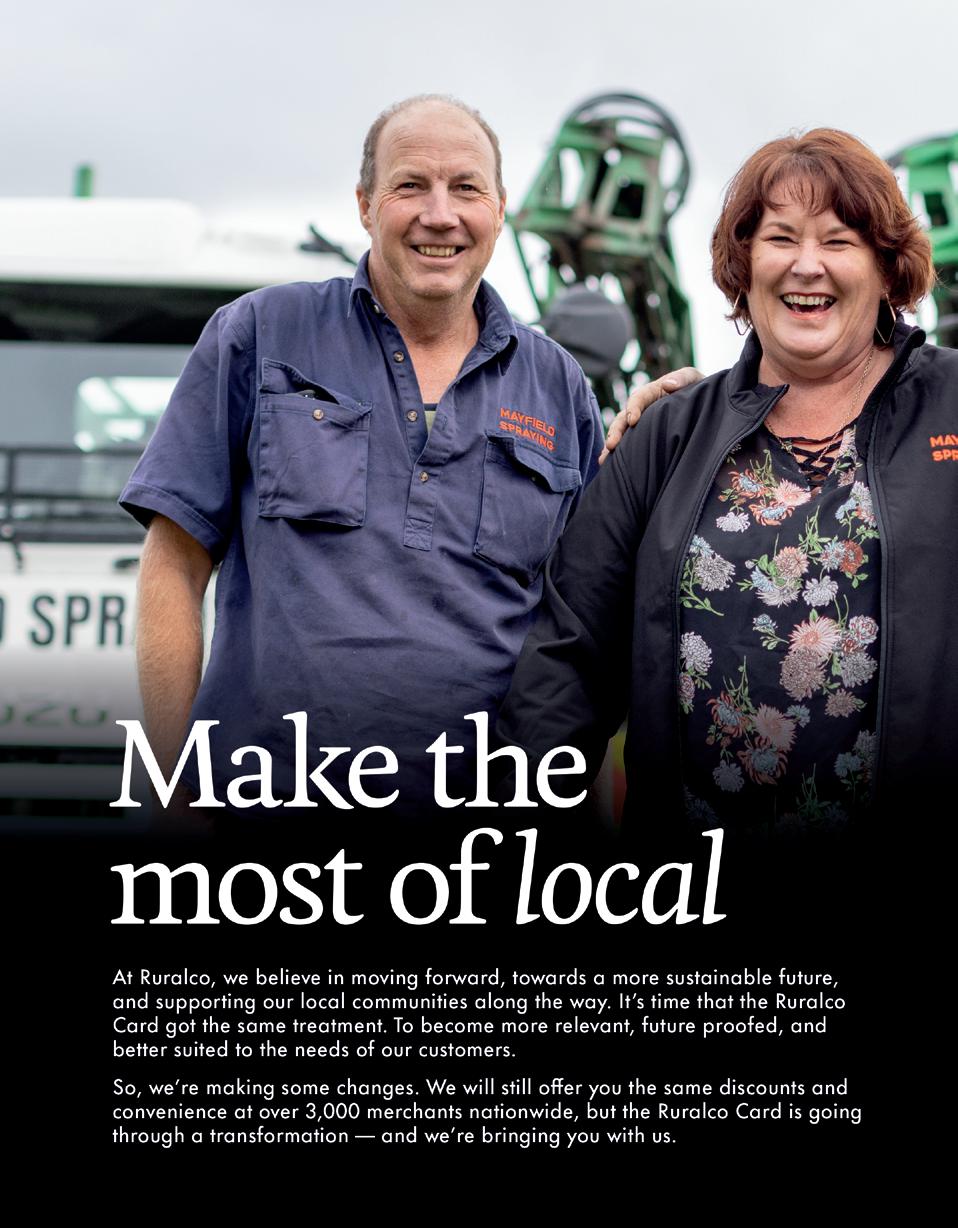
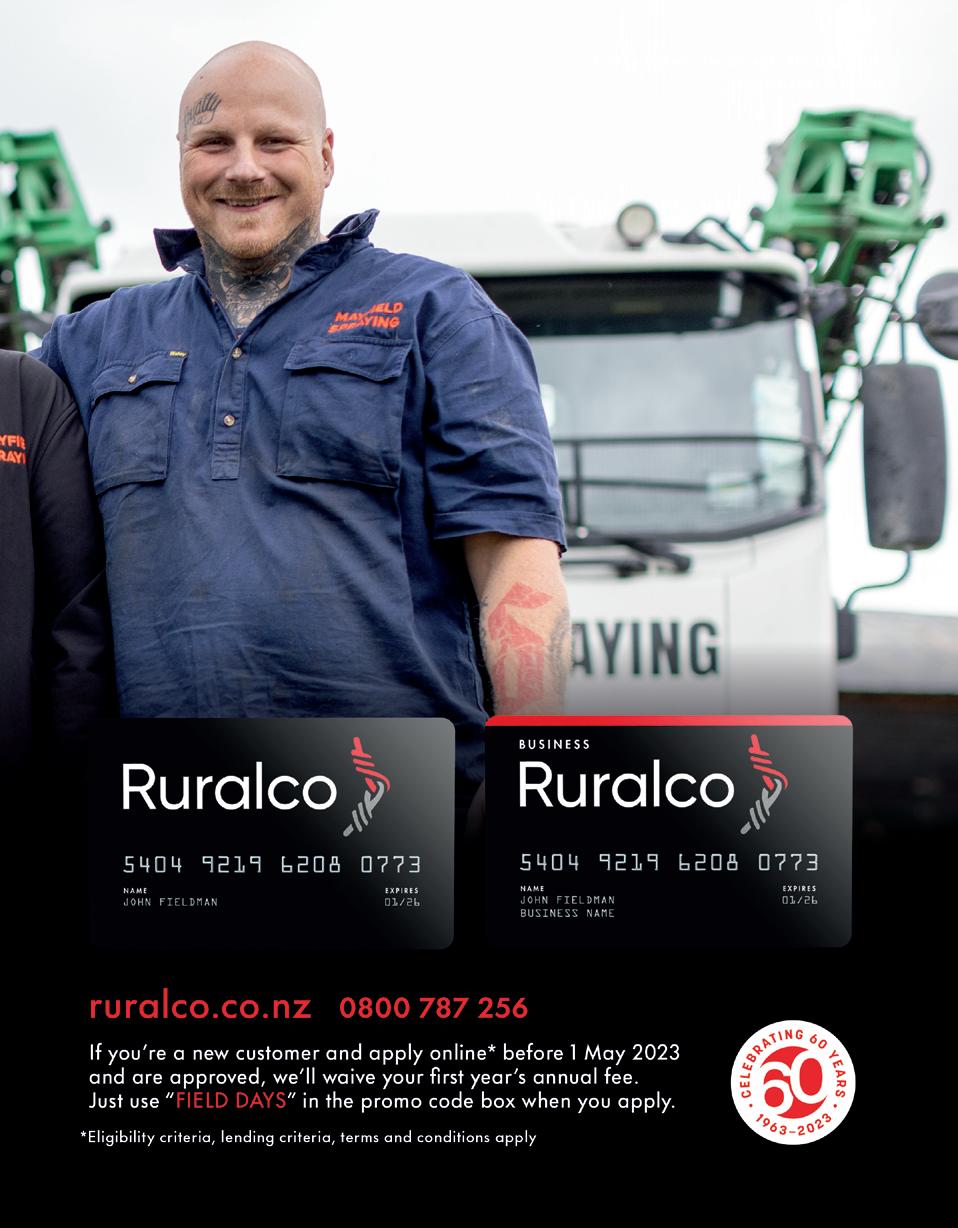
The demand for pest control was growing, and Mike had been suffering from a repetitive strain injury which was making window cleaning a strenuous task.
The change to pest control promised to be more sustainable, and Mike said it felt like a natural progression given his experience dealing with people’s homes and businesses.
In 1995 Spiderban was founded. The name is now commonly recognised across the South Island, however after selling the business divisions in other territories Mike oversees operations from Rakaia to the bottom of the South Island.
Spiderban’s treatments can prevent insects of all sorts from entering and breeding in and around properties, including whitetail spiders, ants, and flies.
Mike says he services a lot of commercial and business premises as well as residential properties.
His treatments can be applied to dairy sheds and production buildings to control the populations of insects and rodents. Spiderban’s treatments are odour-free, safe for pets and family, and can be applied to both building interiors and exteriors for increased effectiveness.
Spiderban Ltd and Farmers Mutual Group (FMG) were celebrated for their excellence in business at the 2022 annual Ruralco Supplier Awards, held in November last year.

WORDS BY INDIANA ROBERTS, IMAGES SUPPLIED BY SPIDERBAN
First time winner Spiderban Ltd received numerous positive accolades from customers, leading them to take out the Members’ Choice Award.
The Ashburton-based business, which specialises in applying treatments to buildings to control pest species, was praised for its “friendly and prompt service,” “good value for money,” and “great communication”.
All of which are values that Mike Ward, owner and technician of Spiderban, claims should be at the forefront of every business owner’s mind. His team—comprised of four technicians and three administrators—service commercial and
residential properties from Rakaia right down to Invercargill.
“We never charge travel,” Mike says. “It’s all incorporated into a run when we do our work. Sometimes there’s a bit of a wait time because of that reason. We have to try and make it as economical as we can to run our business so that we can pass those savings we’re making onto our customers.”
Providing excellent customer service has always been at the core of his business, he says.
“Giving customers value for money is important. That’s one of the things we pride ourselves on.”
He believes all businesses, particularly those who are small, should look for ways to keep their costs down so that customers can reap the benefits. “We’ve always done that and to be recognised for it is really great, it just shows how much effort we put in to doing that.”
Mike started Spiderban Ltd 28 years ago, after spending a decade in the window cleaning industry.
“On our website we’ve got a preparation page and we guide our customers to that,” Mike says. “With babies or ladies who are pregnant, it’s still safe for them but they just need to follow extra precautions because they may be more sensitive.
“There’s a lot in there. People know when they’re using our service that we’ve looked into it, and we’ve given them the guidance to have a safe treatment.”
Mike says part of what contributes to their customer’s raving reviews is the trust they build with their clientele.
They offer a free cobweb removal service included with their spider proofing treatment, which is a testament to the effectiveness of their product and service. “People realise when the cobwebs don’t come back that the spiders won’t either.”
Mike’s ability to consistently uphold excellent service throughout all aspects of his business has led him to build a brand that customers love and trust.
Throughout the month of September, when voting for the Ruralco Supplier Awards was open, Spiderban was nominated dozens of times for the Members’ Choice Award.
Mike says he was overwhelmed by the response and grateful to have received such a popular award. “Thank you to all our valued customers who continue to support us, and who voted for us,” he says. “To meet your expectation of our service, is our success.”
Ruralco card holders who nominated Spiderban for the Members’ Choice Award praised their efficiency; customer service and care; professionalism and great communication.
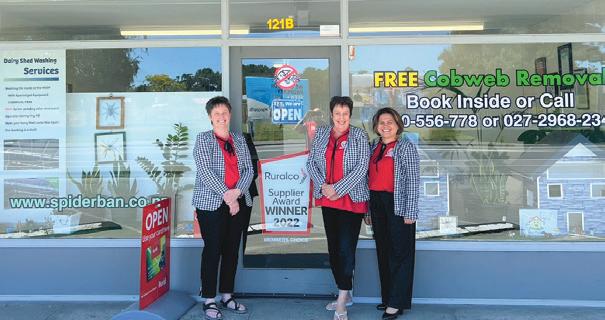
support New Zealand agribusiness and rural communities.”
”We will once again be donating our prize to Farmstrong—an initiative that helps farmers, growers and their families better cope with the ups and downs of farming. We’re proud to support such a fantastic initiative that continuously helps people in rural communities look after the most important asset on farm—themselves.”
Supplier awards both being hotly contested each year.
“All of the winners are fantastic suppliers and supporters of Ruralco and our members,” says Lester.
Ruralco’s Supplier Awards highlight the innovation and success of businesses across New Zealand that lend value and support to the agricultural industry.


Keep an eye out for the 2023 Supplier Awards coming up later this year.
LEFT
LEFT
BELOW: Michael McCone and Gareth Morgan from FMG with Ruralco Merchant Acquiring ManagerJason McKenzie
BOTTOM: Hamish Wilson from 100% Smith & Church with Ruralco Merchant Acquiring Representative Jo Hyde
“They’re good people to deal with,” wrote one customer in their nomination. “They are always friendly and have customers all over the South Island. This tells you the quality of their service. Local people who are people focused.” Another nomination claimed the team at Spiderban “always get here on time. Do a great job. All members of the team are efficient and polite. Mike is great to work with.”
Both Spiderban Ltd and FMG were honoured to be taking home awards from Ruralco’s 2022 Supplier Awards evening. The Supreme Supplier Award was awarded to FMG for the second time consecutively.
FMG Head of Alliances and Industry Partnerships, Scott Kahle says “We’re chuffed to have won the Supreme Supplier Award once again. We’re very proud to be acknowledged by Ruralco, which, like FMG, exists to
The awards evening also recognised excellence in several other business categories.
Aakland Chemicals took out the Animal Feed & Health Award, Great Southern Timber Ltd won the Building & Fencing Award, and Mainfert took out the Farm Merchandise Award.
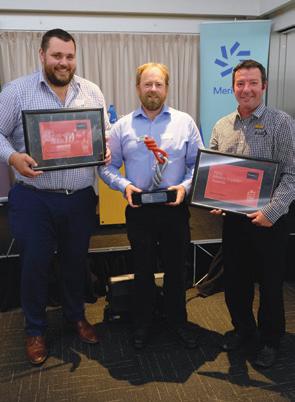
Diesel-Tech Machinery Ltd won the Farm Services award, Netherby Meats Ltd won the Food Award, and FMG also won the Professional Services Award.
Smith & Church Appliances + Beds won the Retail Award, while ElectraServe Limited won the Trade Services Award and Neumann’s Tyre Services Limited won the Vehicle & Small Engine Award.
Ruralco’s National Sales Manager, Lester Chambers says the Supplier Awards have been running for over 10 years with the highly coveted Members’ Choice and the Supreme


Between them, Ruralco Arable & Pastoral Representatives Ricky Brown and Steve Lawson are looking forward to delivering a personable and knowledgeable start to the new season.
Having completed a Diploma of Agriculture at Lincoln, then spending eight years in the navy as a chef, Ricky, the team’s newest member, then returned to his roots in the ag industry working his way to becoming an agronomist at Midland Seeds. Ricky brings a sound understanding of the seed industry and farmers’ needs to Ruralco, covering the spectrum of seed varieties including pastures, forage options, hybrid crops, oil seed crops and grains. “In some respects, I have been a Ruralco customer ever since I moved back, my parents farmed on Banks Peninsula, selling up to farm at Mount Somers running sheep and beef before Dad retired to Ashburton. Like many in Canterbury I have a Ruralco account, and have always appreciated the strong co-operative nature of the business. Working here I come with a good level of familiarity of what Ruralco means.”
WORDS BY RICHARD RENNIE, IMAGES BY ANNIE STUDHOLMERuralco Seed Sales manager John Scott says Ricky brings a new level of energy to the role, and engages well with Ruralco members.
For Ricky there is a particular challenge in a role that requires a broad, sound level of knowledge that covers an ever-increasing array of crop options. Interest in the likes of regenerative type seed mixes and maize hybrids have been two of the more recent options sometimes raised by farmers revising their cropping plans.
The past season did bring some supply line challenges, but Ricky says taking the view that there is a solution to every problem meant Ruralco was able to meet their customer’s needs.
“The beauty of this role is that we are working alongside farmers to optimise their cropping and feed options, offering good advice and helping ensure their farm business’s success.”
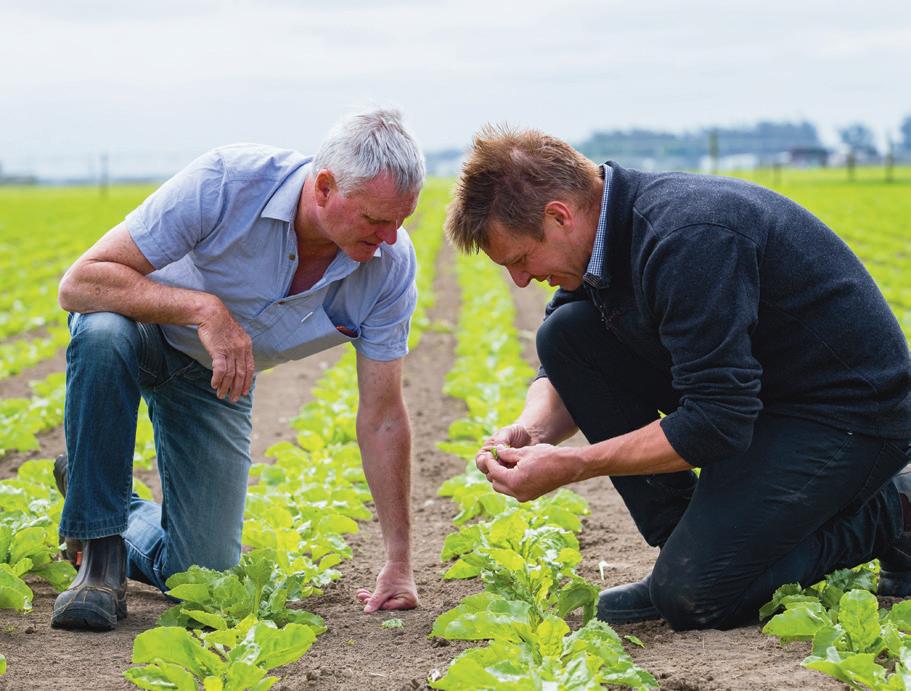
For Ruralco’s long standing Arable and Pastoral representative Steve Lawson, this season’s yields are looking good, after a bumpy start that included a wet, colder spring and a slow start to crop growth.
“Initially it was hard to know how things were going to go, but over summer, we have had some good hot days, and everything started looking far more promising.”
Steve does not envisage too many changes in crop mixes being planted in the coming season, with many grain growers keeping one eye on the dairy payout, a key determinant of feed grain value and therefore volumes to be planted in the coming season.
“Overall, the area committed to cereals is pretty much at capacity on the Plains, while the mix of what cereals actually go in may change a little.”
He is hoping his clients see some easing of input costs as the worst of the covid induced supply issues continue to ease.
After 20 years in the Ruralco family Steve still gets a kick out of working in a region that demands almost encyclopaedic knowledge of crops and how to grow them.
“Generally, I think farmers are doing a better job than they were even a decade ago, their timing is better and the treatments for crops are always improving too.”
He continues to enjoy working with long term clients who have remained loyal over the years, building strong, trusting relationships with many.
“Canterbury has evolved with irrigation and dairying coming along, and we have managed to evolve with it, it’s not like the change has happened all at once and our ability to help farmers out has grown alongside those changes.”
John Scott, Ruralco’s Seed Sales manager says after last year’s tough harvest the industry is crossing its fingers for a better run this year. Generally cereal crops are looking good, despite some concerns around earlier damper conditions increasing disease pressure.
“It continues to be a pretty volatile time for the sector in general, with challenges of on-going cost increases across the board, and the supply challenges faced by many over the past year.
“We are however now confident we can meet all the needs of our farmers, backing the products with a level of service unsurpassed for its experience and understanding of our clients’ needs,” says John.
Ruralco’s team of experienced account managers are gearing up for the annual round of on-farm meetings with clients, sitting down around the kitchen table to hammer out cropping options, rotations, seed types, and
treatments to develop a forward plan for the coming seasons.
“We have been working on these for the past five years, and they are growing in popularity. It works well for our clients, giving them an opportunity to take a breath and consider where they want to go for the season, while also helping Ruralco with planning and stock ordering.”
Ruralco’s seed guides are proving popular showcasing the increasingly varied options for grazing, ranging from brassicas through to fodder beets, grass options and some catch crop varieties.
After some industry wide disruptions in the past couple of years, this season is looking secure for ag-chem and seed sourcing. While the area in arable crops tend to remain relatively fixed, there will inevitably be some shifting around on what crop type goes in. This season the uncertainty around store lamb prices could induce some farmers to consider wider crop options to buffer against some lower than anticipated livestock returns.
“We are also keen to ramp up our role as a significant buyer and seller of grains, namely in
wheat and barley. It is a big part of our business, and we have the expertise and coverage in the industry to build on that even further.”
Farmers wanting to keep their finger on what the grain market is doing can also look to Ruralco’s Grain Report, providing monthly updates on the grain and seed market for regular, informed, and useful news on what is happening here, in Australia and around the global grain markets.
“We are looking forward to a good year, with a knowledgeable team who are enthusiastic and great to work with. They are always happy to go the extra mile for our shareholders wanting to get the most out of their crop options during the year.”
OPPOSITE: Ruralco Arable & Pastoral Representative
Ricky Brown investigates a fodder beet crop with farmer Tony Tarbotton

LEFT: Steve Lawson, Ruralco Arable & Pastoral Representative, admires a winter feed crop
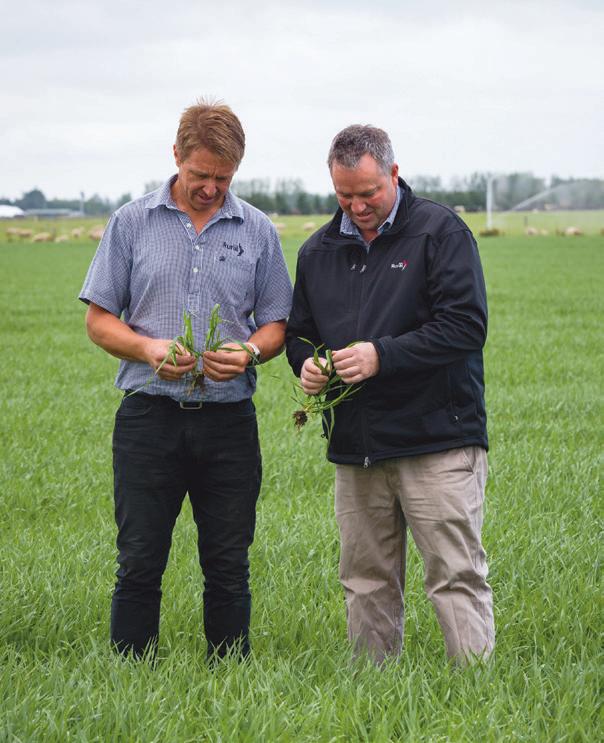
BELOW: Ruralco Arable & Pastoral Representative
Ricky Brown and Ruralco Seed Sales Manager
John Scott assess a young oat crop


Is magnesium (Mg) important for winter wheat yields and quality, and what’s the best course of action if a deficiency occurs?
As wheat yields have increased over the years, more Mg has been removed from the soil, raising the question as whether this impacts future yields and quality.
In wheat, Mg drives photosynthesis, protein synthesis and carbohydrate metabolism, so researchers have wanted to find out if a soil Mg deficiency could affect wheat yield and protein content. Magnesium may also help water use efficiency.
Between 2003 and 2020, New Zealand farmers’ wheat yields increased 60 per cent on average (from 7.48 t/ha to approximately 12 t/ha), due to improved cultivars and agronomic management. But as yields have increased, so too has the amount of Mg removed from the soil, and anecdotal reports of Mg deficiency.
While wheat only requires a small amount of Mg which can usually be met by soil reserves, researchers have focused their attention on the issue of low soil Mg levels due to the possible impact on yield and quality.
For most arable crops such as wheat, a soil Quick test (QT) of Mg > 10 has traditionally been considered sufficient. However, in research on Mg on winter wheat in 2001, even when Mg soil levels were relatively low (QT Mg of 3–4) applying Mg did not increase wheat yield or quality1
These results were echoed in a 2020 Mg trial, which assessed the timing (autumn/spring), type (slow/quick acting), and rate of Mg (0–75 kg Mg/ha) on yield and quality of winter wheat on soil with an average of QT 9 Mg (still below the optimum for arable production). The various Mg fertiliser treatments once again made no significant difference to yield or quality, but applying Mg fertiliser did increase Mg concentration in herbage2
The optimum herbage level for wheat is thought to be 0.10 to 0.16 per cent Mg, but in early spring in New Zealand it is not uncommon for Mg herbage concentrations to be below 0.10 per cent, generally due to wheat’s slow uptake of Mg during the cooler weather.
When soil QT Mg levels are maintained sufficiently for other crops or pasture grown in rotation with wheat, Mg is unlikely to limit yield or quality of wheat, as wheat appears to be more tolerant of low Mg levels.
However, if farmers are concerned about a low winter wheat herbage Mg concentration, they have two options based on previous trial work. The first is to apply 50 kg Mg/ha in spring in the form of Kieserite.
Alternatively, 25 kg Mg/ha in the form of Serpentine Super can be applied in autumn and an additional
25 kg Mg/ha in the form of Kieserite in spring. Serpentine Super is 5 per cent Mg and is a source of phosphate and sulphur required by wheat. Studies carried out by the Fertiliser and Lime Research Centre have shown the release characteristics of the Mg in Serpentine Super. Serpentine Super was still releasing Mg for plant uptake 30 months after application. Herbage from plots treated with Serpentine Super contained 57 per cent more Mg than herbage from control plots, indicating fertiliser Mg uptake by plants3
Other Mg fertilisers such as dolomite could also be considered in the autumn, depending on the cost-effectiveness of the Mg, and if liming is required.
1 Craighead M 2001. Magnesium deficiency in crops and its relevance to arable farming in New Zealand - a review. Agronomy NZ 31: 2001
2 Brooker TP, Dawson AE, Field CG 2021. Does the timing and rate of magnesium fertilisers affect yield and quality of winter wheat? Agronomy New Zealand 51: 2021
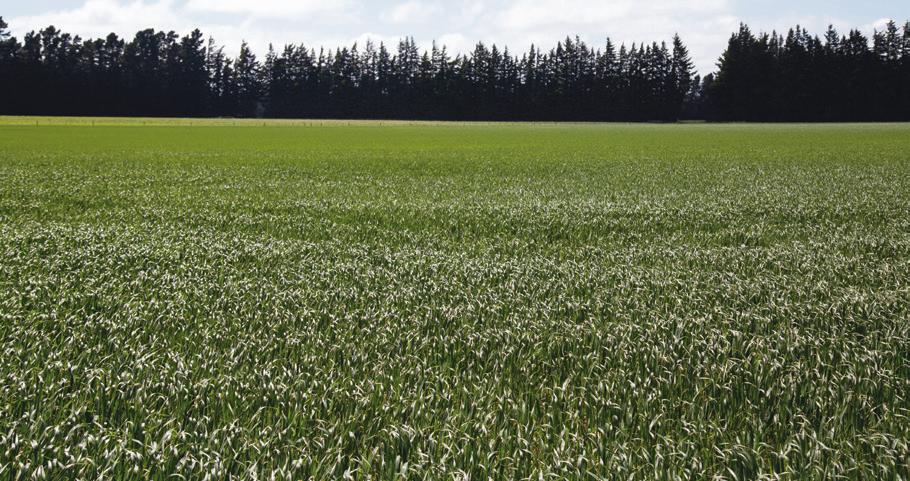
3 Loganathan P, Hanly JA, Currie LD 2005. Effect of serpentine rock and its acidulated products as magnesium fertilisers for pastures, compared with magnesium oxide and Epsom salts, on a Pumice Soil. 2. Dissolution and estimated leaching loss of fertiliser magnesium, New Zealand Journal of Agricultural Research, 48: 461–71
ARTICLE SUPPLIED BY BALLANCE AGRI-NUTRIENTS

This short 4.7km walk takes you to the Putangirua Pinnacles and the Pinnacles Lookout. Generally considered a moderately challenging route, it takes an average of 1 hr 49 min to complete. Dogs are welcome and may be off-leash in some areas. Scenes from Lord of the Rings were filmed at this location. Great loop with a rocky river up to the beautiful pinnacle formations, a walk through the woods up to the viewpoint, and a muddy trek through a palm grove. Please note: offline map is recommended to get oriented as several users have reported that this trail is not well marked.



This track will take you from the Crown Saddle car park to the summit of Rock Peak located in the Pisa Conservation Area. Considered a moderately challenging route, it takes an average of 2 hr 52 min to complete. The track follows an old 4WD road with a transmitter station on the top. Some sections are steep, but there are great views along the way. Note: This track crosses into private land at times. Keep on track. Dogs are welcome and may be off-leash in some areas— just remember to pick up after them!
This out-and-back trail near Ashburton takes an average of 5 hr 21 min to complete, and will take you from Potts River car park to Mystery Lake. It’s a well-marked trail across tussock-covered hills. There’s a very short climb from the riverbed near the start then it is just a gradual ascent for the next few km. The last gradient for the last couple of km is a little steeper but still not too bad for anyone of average fitness. Dogs are welcome and may be off-leash in some areas—just remember to pick up after them!
Generally considered an easy route, this loop trail near New Plymouth takes an average of 1 hr 10 min to complete. The walk may be started at either end of Lake Rd, where there are spectacular views of Mount Taranaki. The lower lakeside route takes you on an ambling walk close to the lake edge. Lakeside vegetation and regenerating pockets of native bush provide a cooling atmosphere and a home to many birds. Dogs are welcome, but must be on a leash.

 With Indi Roberts, Ruralco Marketing Assistant
With Indi Roberts, Ruralco Marketing Assistant


 BY MARC CAMERON
BY MARC CAMERON
1985: A top secret F117 aircraft crashes into the Nevada desert. The Nighthawk is the most advanced fighting machine in the world and the Soviets will do anything to get their hands on its secrets. In East Berlin, a mysterious figure contacts the CIA with an incredible offer-invaluable details of his government’s espionage plans in return for asylum. It’s an offer they can’t pass up...if it’s genuine, but the risks are too great to blindly stumble into a deal. With the East German secret police closing in, someone will have to go to behind the Berlin Wall to investigate the potential defector. It’s a job Deputy Director James Greer can only trust to one man—Jack Ryan. Ryan is a former Marine and a brilliant CIA analyst who’s been the architect of some of the CIA’s biggest coups but this time he’s in enemy territory with a professional assassin on his tail. Can he get the right answers before the Cold War turns into a Red Winter?
• 250g cream cheese
• 1 Maggie creamy chicken recipe base
• 300-400g chicken, diced
• 1 ½ cup milk + 1Tbs milk for coating pastry
• 1 medium onion, diced
• 4 cloves garlic, minced or diced
• 2 tablespoons olive oil

• 1 head broccoli, cut into small florets
• 1 sheet of Edmonds flaky puff pastry

• 1 cup of diced mushrooms (optional)
• 2 handfuls of baby spinach (optional)
• Salt and pepper to taste
Diced onion and garlic and cook in olive oil over medium heat until fragrant.
Dice chicken and add to onion and garlic, cooking until browned. Add cream cheese and stir until melted to coat chicken. Add vegetables (broccoli, mushroom, baby spinach).
Pre-heat oven to 180ºC, fan bake.
In a jug, mix Maggi recipe base and 1 ½ cups milk. Pour over chicken and vegetables, and stir until simmering. Add salt and pepper to taste, and simmer until thickened. Once mixture has thickened to a pot pie consistency, remove from heat and transfer to oven proof dish. Layer one sheet of Edmonds puff pastry over top. Brush with milk and place in oven.Cook for roughly 20 minutes, or until pastry is puffed and golden.
A delicious, low mess meal which will be a winner for the whole family, perfect for chilly evenings and disguising vegetables for the kids.
The story of two women spanning the Russian Revolution to the Nazi occupation of the Soviet Union.

Russia 1917: Beautiful, educated Svetlana Petrova defied her stifling aristocratic family to join a revolution promising freedom. Now, released after years of imprisonment, she discovers her socialist party vying for power against the dictatorial Bolsheviks and her beloved uncle, a champion of her cause, was murdered by a mysterious assassin named Orlova. Her signature blinding her victims before she kills them. Svetlana resolves to avenge his death by destroying this vicious opponent, even as she longs to reunite with the daughter she has not seen in years.
USSR 1941: Now living in obscurity in a remote village, Svetlana opens her home to Mila Rozovskaya, the eighteen-year-old granddaughter from Leningrad she has never met. She hopes to protect Mila from the oncoming Nazi invasion, but when the enemy occupies the village, Svetlana sees the young woman fall under the spell of the resistance-echoing her once-passionate idealism. As Mila takes up her fight, dangerous secrets and old enemies soon threaten all Svetlana holds dear. To protect her family, she must confront her long-buried past—yet if the truth emerges victorious, it holds the power to save or shatter them. A risk Svetlana has no choice but to take.
Love, Pamela brings forth her true story, that of a small-town girl getting tangled up in her own dreams. Growing up on Vancouver Island, the daughter of young, wild, and unwittingly stylish parents, Pamela lived a hardscrabble childhood but developed a deep love for nature, populating her world with misfits, apparitional friends, and injured animals. Eventually overcoming her natural shyness, Pamela let her restless imagination propel her into a life few can dream of, in Hollywood and the Playboy Mansion. As her star rose, she found herself becoming a fixture of tabloid fodder, at the height of an era when paparazzi tactics were bent on destroying a person’s image and self-esteem. Pamela forged ahead with grace, finding sanctuary in her love of art and literature, and emerged a devoted mother and activist. Now, having returned to the island of her childhood, after a memorable run starring as Roxie in Chicago on Broadway, Pamela is telling her story, a story of an irrepressible free spirit coming home and discovering herself anew at every turn. With vivid prose interspersed with bursts of original poetry, Love, Pamela is a pensive, layered, and unforgettable memoir.


ROBERT GORDON POTTERY IS A FAMILY OWNED AND OPERATED BUSINESS THAT HAS BEEN DESIGNING AND CREATING QUALITY POTTERY PIECES SINCE 1945. FOUNDED BY BARBARA AND ROBERT (AKA ANDY) GORDON, THEY FOCUS ON DESIGNING POTTERY THAT IS BUILT TO LAST AND SUPPLY SOME OF THE WORLD’S MOST REPUTABLE RETAILERS.



AVAILABLE AT RURALCO





Established in 1967, Baron & Buxton has been designing wallets, handbags, travel luggage, and small leather goods for over 50 years, becoming a brand of quality in New Zealand.

A family owned and operated business, Choice Fruit Products produce artisan condiments and spice mixes harvested from local produces. Made in the Wairarapa, they focus on quality, flavour and colour and are big advocates for fresh, seasonal, local, and organic ingredients.

CHECK OUT THESE TOP TIPS FROM THE HONEST CONSUMER FOR UPCYCLING AND REPURPOSING YOUR CANDLE JARS:
1. Use the jar for storage, especially if it has a lid.
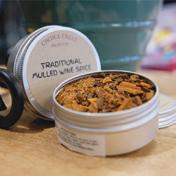
2. Use the jar as a vase.
3. Paint the jar and use it as a decoration.
4. Make a homemade salt scrub (you can find a recipe on The Honest Consumer’s website, linked below).
5. Fill it with candies and regift it.
6. Use it as a plant pot.


7. Upcycle into a new candle jar.
Follow their tips for preparing your candle jar for its new purpose:


To remove the wax from your candle jar you’ll need a butter knife and some warm water. Heat the water on the stove top, pour the water into the container to loosen the wax, and use the butter knife to further lift the wax up and loosen the wick. The heat from the water will cause the wax to melt and rise to the top. You might need to use some tongs to pull the wick out of the container. Finally, use one of the utensils to remove any large pieces of wax and use a paper towel to wipe away the remaining wax. Once the wax is removed rinse out a few extra times with hot soapy water to ensure your jar is clean for crafting!

For more information, visit www.thehonestconsumer.com/blog/ how-to-repurpose-candle-jars
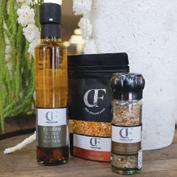
If you don’t have any candles to repurpose, we highly recommend the Woodwick range. Featuring a wooden wick that crackles softly when lit, the Woodwick range is perfect for creating ambience and releasing beautiful aromas.

Designed and created by Rachel, Hugs and Kisses showcases a beautiful selection of handmade children’s accessories and homewares. Her passion lies in creating practical boutique products that make wonderful gifts for any occasion.



Autumn is wonderful time to get your garden ready for the following seasons. Make use of the soft soil and the natural mulch of falling leaves to get your winter vegetables sown and your spring flower bulbs buried. Spruce up your lawn with some top tips for re-sowing and weed control.
Now is the perfect time to dig over the ground in preparation for new winter crops. Add in organic compost and follow with a dressing of garden lime. Do this several weeks before fertilising and planting new seedlings.
Once the soil has been prepared seedlings of cauliflower, broccoli, cabbage, Brussels sprouts, spinach and silverbeet can be planted out.
Carrot and parsnip seeds can be sown directly into the garden. For a succession of other crops sow seeds of cabbage, broccoli, cauliflower, silverbeet in seed trays for planting out later in the season.
Any areas of the garden which are not going to have a winter crop can be sown with a green manure crop such as blue lupin or mustard. These crops can be dug in in early spring to provide structure and nutrients to the soil.
This month you can start to plant tulips plus all the other favourites, including daffodils, freesias, crocus, Lachenalia, hyacinths.
The flower garden can now be replanted with seedlings of Polyanthus, Primulas, Pansies, Stock, Calendula. Remember proper preparation is the key to success. Start preparation for re-sowing lawns. Spray weed killer to remove weeds, wait at least three weeks after spraying before sowing new seed. Fix any lumps, hollows, or bare patches. Re-sow lawn seed when ready and water daily until fully germinated.
April’s the time to be planting strawberries. Strawberries like good fertile soil so dig in lots of top-quality compost before planting. A handful of Blood and Bone in the planting hole and a top dressing of general fertiliser will get them off to a flying start. Remember to water in well after planting.
Spinach, cabbage, winter lettuce, bok choy, should all be part of your winter garden. Broad beans are a great winter garden crop - plant seeds now into prepared soil. You can also plant shallots and rhubarb in April. Shallots are easy to grow and take up little space in the garden. Rhubarb is planted by ‘crowns’ which are available this month. Rhubarb plants are heavy feeders so dig in plenty of top quality compost at planting time and follow up with general garden fertiliser at regular intervals through the year.
Winter lettuce can be planted in April - be sure to choose winter varieties such as ‘Winter Triumph.’ Continue planting seedlings of cabbage, cauliflower, leeks, spinach and silverbeet.
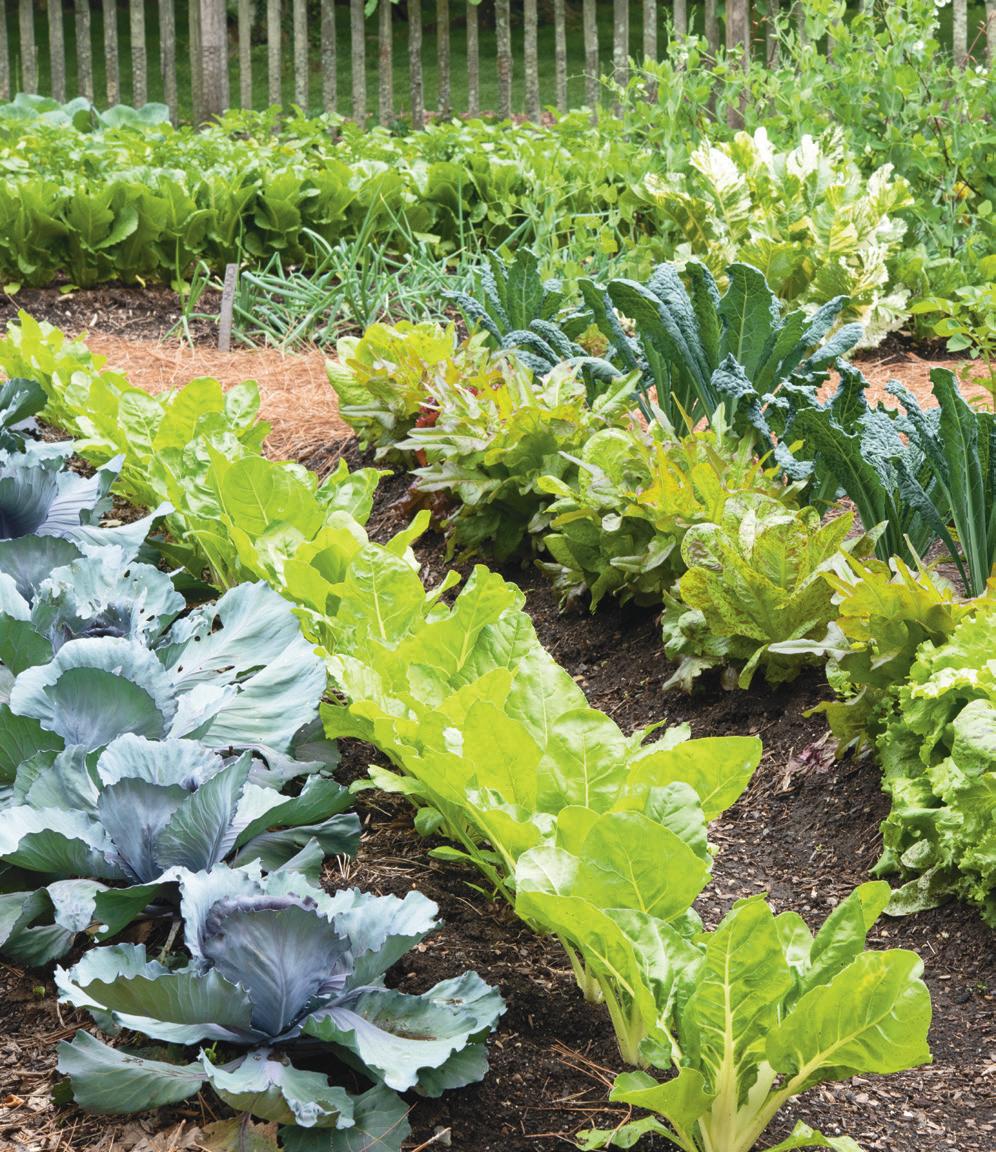
Fruit trees that have been harvested and are starting to shed their leaves can be given a clean-up with a copper spray—this will help kill off any overwintering fungus spores.
April is a good time to start planting deciduous fruit trees which will all be appearing in the garden centrepeaches, plums, nectarines, apples. This is also the last month for planting spring flowering bulbs. Mix bulb food into the soil when planting - this will get them off to a good start once the roots start developing.
Prune back shrubs and climbers that have finished flowering.
Plant out Primulas, polyanthus, pansies, violas, cineraria, sweet pea, and stock.
Autumn is a great time to sow new lawn as there is still enough warmth in the sun and a bit of rain to help with the watering. Control broadleaf weeds in established lawns with the relevant weed control product.
VISIT US:
Visit Lushingtons for all your autumn gardening needs and get up to 7.5% discount when you use your Ruralco card.

Use your Ruralco card &
SAVE UP TO 7.5%
Prune back shrubs that have finished flowering and feed with a fertiliser high in potash such as Rose fertiliser.
Lift and store dahlias and gladioli. Plant Lily bulbs now. Spray deciduous ornamental and fruit trees with Lime Sulphur. This stops lichen from growing and helps control overwintering diseases and insects. Protect young seedlings from slugs and snails with Quash or Baysol snail pellets (check for any health warnings associated with domestic pets).
Winter colour—plant out winter flowering annuals and potted colour now for great colour through the winter months.
Give hedges a final trim and tidy up before winter. Plant out new hedges and shelter now—Corokia, Griselinia, Pittosporum, Buxus, Photinia, all make attractive, low maintenance hedges in the home garden.
Feed lawns for autumn if you haven’t already, it will boost growth and suppress weed growth.
New seed can be sown this month.
Rake leaves off lawn to stop them composting on the grass.
APT GARDEN CREATIONS, BASED IN ROLLESTON, CANTERBURY, HAS BEEN DESIGNING AND BUILDING RAISED GARDEN CANOPIES SINCE EARLY 2020.
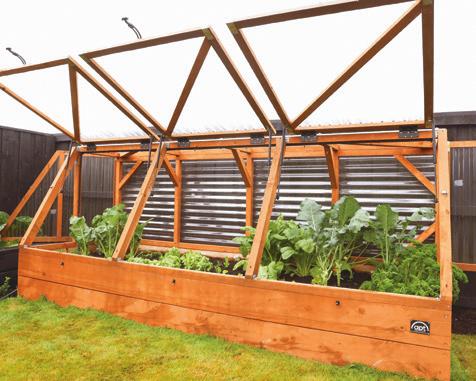
Their canopy garden beds offer a perfect solution to stop cats, dogs, chickens and pest species from destroying your vege garden, and work to shield plants against frost and wind.

With the option of adding gas struts to the main front doors and an internal irrigation system, the canopy garden beds take the hassle out of gardening so you can enjoy the fruits of your labour.
VISIT US:
Get a discount of up to 5% when you use your Ruralco card with Apt Garden Creations.
w: www.aptgardencreations.co.nz
ARROWTOWN AUTUMN FESTIVAL
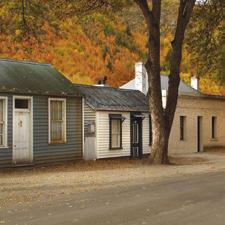
20–25 APRIL 2023
Bask in the glory of Arrowtown in autumn at the historic town’s annual Autumn Festival. Held in April during the height of autumn, you will witness eerie frosty rivers backdropped by splashes of vibrant colours, brought to life by the leaves of the many deciduous oaks, sycamores, cork elms and ashes planted over the centuries. A market day, local performances, and a street parade add to the festivities. Venture to or from Queenstown, only a 25-minute drive away, for more spectacular views and an array of quality dining and accommodation options. Check out our website to see where you can use your Ruralco card.
TARANAKI TASTE & TALES
WEEKENDS ACROSS MAY
Perfect for any food lover, Taste and Tales offers an exciting opportunity to explore the Taranaki region and experience some delicious local produce. Learn about different boutique food producers and enjoy a tasting session with behind-the-scenes access to understand what makes their food so flavoursome. Taste and Tales’ Farms & Food tour provides the perfect opportunity to explore some amazing farmlands, from a sheep and beef station in the Matarata Downs to a boutique dairy farm in the Kaitake Ranges.
Use your Ruralco card &
SAVE UP TO 5%






By increasing soil quality on their farms, farmers are not only helping to improve the environment, but also their crop yields and returns, says the author of a guide on soil management, Abie Horrocks of the Foundation for Arable Research. WORDS AND IMAGES SUPPLIED BY HEATHER CHALMERS, FOUNDATION FOR ARABLE RESEARCH
and clay, for example, is part of the inherent properties of your soil. But really it focuses more on those things that are in your control that can really help improve soil quality.”
As arable farms have periods of restoration as well as depleted phases across the rotation, farmers are urged to “get their eye in”, regarding how these affect soil quality and how management can keep that heading in the right direction, bearing in mind that it does fluctuate. The simplest way to do that is with visual assessments, Abie says. “Sending samples off to measure organic matter and carbon are very helpful as well, but just doing a visual assessment is a really accessible option to assess where your soil quality is at. This is because you can see what’s happening if you get out there with a spade.”
The FAR Focus guide also includes four arable farmer case studies where growers outline the actions they take, or avoid, on farm to maintain and improve soil quality.
The FAR Focus guide is called “Good Soil is Good Business” and is specifically focused on the management of cropping soils.
New Zealand arable growers understand the benefits of managing their soils to maintain quality and support productivity. Their systems comprise diverse rotations, which include depletive and restorative crops and phases, says Abie, a FAR senior environment researcher.

New Zealand’s high land values, by international standards, mean that soils are a farm enterprise’s major asset, with continuous improvement in soil quality providing clear and sustainable financial returns.
Research work in Southland showed that yields were affected by soil quality and that for every 10 per cent reduction in aggregate stability there was an 8 per cent reduction in wheat crop yield. Based on average autumn wheat yields of 11.6 t/ha from the 2022 Cereal Performance Trials in Southland, that 8 per cent yield loss would equate to 0.9 t/ha, or $500 a hectare loss in income (based on a wheat price of $540 a tonne). Climate change and associated extreme weather events are also highlighting the need for increasing resilience of arable farm systems, and improvements in soil quality have been shown to support long-term resilience through drought tolerance.
“Increasing public and regulatory focus on issues such as nitrate leaching to groundwater, phosphorus loadings in soil runoff and greenhouse gas emissions means there has
never been a more important time for farmers to reflect on their soil and maintain or improve soil quality to build profitability and resilience into their farm system.
“That’s why we’ve written this FAR Focus.”
As well as providing a general outline of New Zealand soils and what makes them unique, the guide discusses what soil quality means, why it matters and how arable farmers can manage the soils on their farm to improve their quality, productivity and environmental credentials. “Although there is no one-size fits all recipe to improve soil quality, this guide is intended to help build on your understanding of how your particular soil can function at its best,” Abie Horrocks says.
While most people have a good idea of what damaged soil looks like, there is no official scientific or regulatory definition of good soil quality.
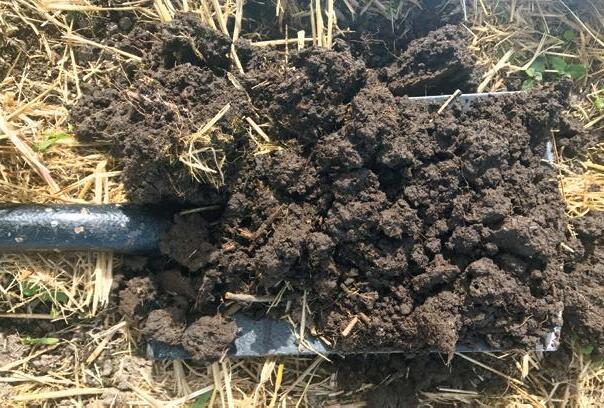
“Just like there is no single recipe to improve soil quality, neither is there a single definition. The point of the guide isn’t to be prescriptive. There’s a whole suite of tools out there that have a place in cropping systems and it’s just really pulling it together so different farms can think about what would work for them.
“It’s thinking more about a soil’s capability to function for a particular land use within its inherent properties. By inherent properties, I’m just referring to those things that you can’t control. So, your soil texture, which comes about from the parent material and how it weathered over time. And so the composition of silt, sand
There are six internationally recognised options for improving soil quality that are covered in the guide. These are:
1. Avoid bare soil (with living plants or residues).
2. Maximise below ground returns of organic matter.
3. Minimise disturbance.
4. Integrate livestock and cropping.
5. Increase plant biodiversity (across and within the rotation).
6. Increase soil fertility through biological means.
ABOVE LEFT: Soil spade test
BELOW: FAR’s Abie Horrocks
ground for six to eight weeks. Previously we would have just left the paddock fallow. If we have grown broad beans for seed we just disc the seeds that have fallen on the ground and add phacelia and buckwheat.
“Once we get into March/April and growth slows down we need to take a cover crop through winter.” Apart from ryegrass and autumn-sown crops, all paddocks have a cover crop through winter.
As the farm grows a lot of seed crops, David is conscious of not using any cover crop species that may contaminate future crops, so no clovers, ryegrass or brassicas are used. He often uses a base mix of oats, phacelia and/or buckwheat, which is easy to control. Cover crops are not allowed to set seed.
Having a cover crop also helps the uptake of nutrients, reducing the risk of leaching, as well as enabling livestock grazing, with trading lambs grazed over winter.
While the farm has been returning crop residues, particularly cereals, into the ground for 25 years, cover crops are driving much faster improvements in soil organic matter/carbon.
Growing of cover crops is now standard practice on David Birkett’s Leeston farm, as the benefits of building soil carbon/organic matter become more apparent.
RESEARCHPaddocks that may have previously been fallowed between crops are now sown in a cover crop, even for short periods of six to eight weeks over summer.
The 200-hectare irrigated mixed cropping farm has a relatively heavy soil type, mostly Temuka silt loam.
Wheat is the biggest crop by area. Other crops are barley, white clover, ryegrass, peas and beans both for processing by Heinz Wattie’s in Christchurch and for seed, and hybrid vegetable seeds, such as radish.
David says he tries to grow nitrogen-fixing legumes as much as he can in the crop rotation, followed by a “catch crop” such as deeperrooted cereals.
“There are times when we do have a bare paddock and we are still working on that, particularly establishing clover, as it doesn’t like competition.” He is finding success with direct drilling oats, which he describes as a “companion
crop” into clover. This is grazed, or removed later in the season, covering the planting cost.
Direct drilling is used as much as possible, which is becoming more successful as the soil improves. “We haven’t ploughed for 10 years and before that only one or two paddocks a year.” One downside is that grass weeds are a problem using minimum tillage, as these can no longer be buried, as occurs with ploughing.
“If we harvest in early January, we often do a cover crop in summer, which may be in the
Roots put 10 times more carbon into the soil than crop residues, he says. This means he is now sometimes baling off excess straw residue to get a better establishment of cover crops. Although yields had plateaued at high levels, David’s soil-focused system means the farm is able to grow good crops with fewer inputs. Inputs have reduced by 30 per cent, mainly nitrogen and some phosphate.
He uses the Potential Mineralisable Nitrogen test which estimates the ability of a soil to supply N for crop growth. “For us, it is up to 130kg/ha and we have found that in a wheat crop it does become available.”
On average, 120kg/N/ha is available in the farm’s soil, which at $3.30kg/N is worth $400/ha.
David says his soil is easier to work and holds more nutrients and moisture.
“If soil is in good condition, biology will be thriving as well. I use visual soil assessment tools, that is digging and looking at the soil structure and worm life. Just by digging it up with a spade you get a good indication.”
ABOVE: A cover crop of broad beans, oats, phacelia and buckwheat (white flower). From a broad bean crop for seed, then into wheat. The cover crop was three-quarters grazed, with the rest left on top of the ground

LEFT: Leeston farmer David Birkett; a spade provides a good indicator of soil quality

WORDS AND IMAGES SUPPLIED BY HEATHER CHALMERS, FOUNDATION FOR ARABLE
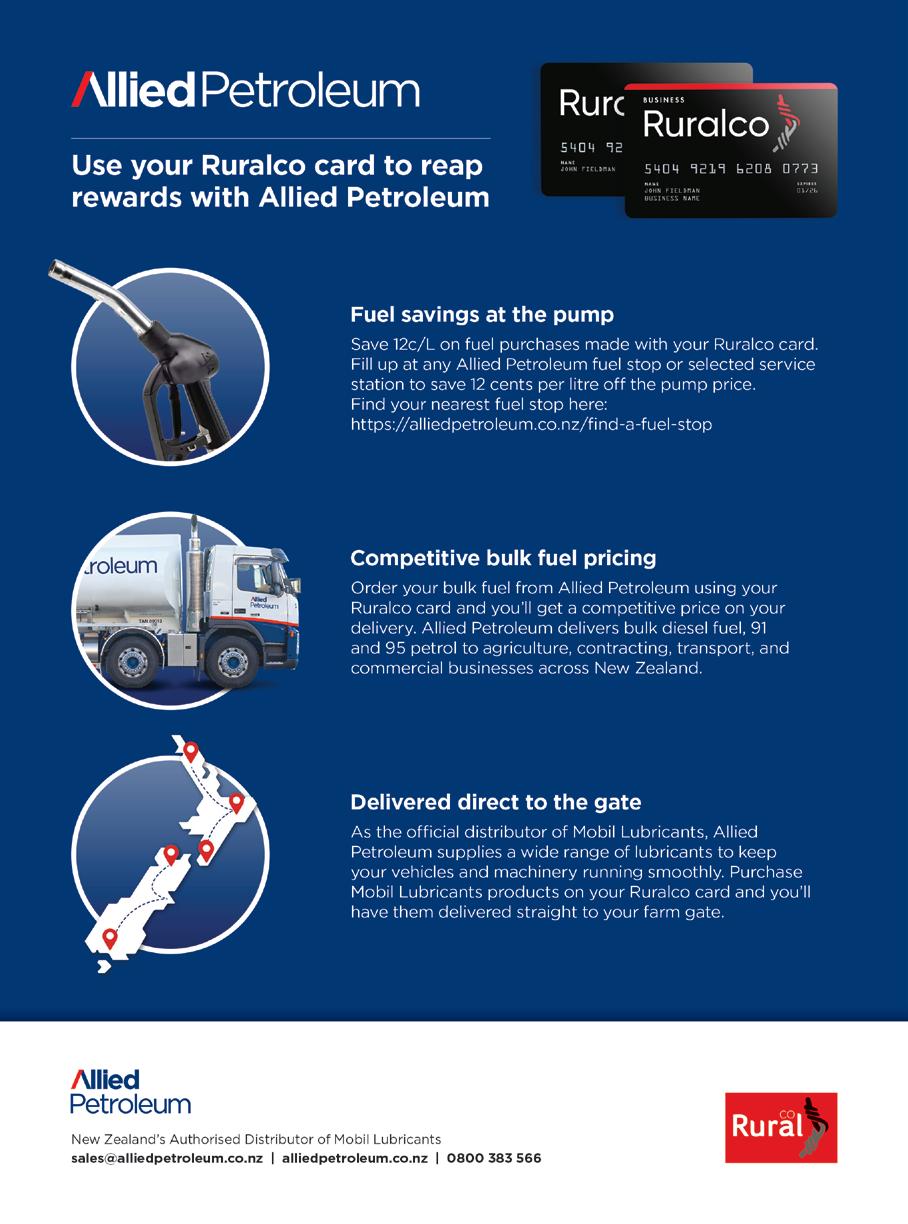
There’s a lot of policy talk at the moment that has many farmers I’ve heard from considering what they can do now, to adapt for the future.
WORDS SUPPLIED BY KEELY BUCKINGHAM, DAIRYNZ SOLUTIONS AND DEVELOPMENT SPECIALIST, IMAGES SUPPLIED BY DAIRYNZ
One of my key pieces of advice is to understand what your key profit and environmental numbers are, to identify improvements in your farm system. It may seem a little overwhelming, but by breaking it down you can easily get to grips with your farm numbers, and what these mean for your business.
Some of the environmental key indicators are purchased nitrogen surplus, nitrogen conversion efficiency, emissions per milk solid (GHG/kg MS) and methane, while your profit is analysed through operating profit per hectare.
Where do the numbers come from?
Your metrics and farm numbers are calculated from data you have already collected and submitted to your dairy supply company or consultant to meet regulatory requirements. Those companies then input your information into programmes or models, such as OverseerFM or the AIM model, to calculate your farm’s numbers. Different reports will
include different information, but the main ones reported are the ‘key numbers to know’ mentioned above.
Once you know your numbers, one of the key things to do is benchmark against other farms. This can be done through the environmental reports from your dairy company, which contain benchmarks to help understand where your business fits, compared to others. These benchmarks give an indication of what good looks like so you can see where you need to be, if you aren’t already there.
DairyNZ has a range of resources to help, including regional graphs to plot your information on, allowing you to compare your farm at a regional level for operating profit, methane emissions and purchased nitrogen surplus. DairyBase also allows you to gain a full analysis of your farm numbers, including benchmarking farm profitability.
You might think everyone operates the same way, but your numbers are not the same as your neighbour’s. So, once you know your numbers, look at your farm system and consider where you can create more efficiencies. Find the areas that need the most attention, such as nitrogen fertiliser, imported feed or
effluent, and determine what adjustments can be made to become more efficient and adaptable for future.
For example, a significant driver for methane emissions is total feed eaten, so this may be something to consider on your farm. Any practice that increases feed use efficiency will reduce emissions, without affecting farm profitability. This would include reducing the amount of feed going to unproductive animals by improving reproductive performance or reducing feed going to maintenance, by increasing per cow production. Our DairyNZ regional teams are always happy to help, so if you have any questions or want support, contact your local team.
More information is available at dairynz.co.nz/ knowyournumbers


Pink Floyd bassist Roger Waters says the line in his song, “We don’t need no education”, was actually about British schools being more interested in keeping kids quiet than teaching them anything useful.
WORDS SUPPLIED BY ANDREW OLSEN CHIEF EXECUTIVE OF RURAL CONTRACTORS NZ, IMAGES SUPPLIED BY RURAL CONTRACTORS NZ.I think New Zealand is in a similar place. I’m not anti-teachers—many do a fantastic job—but the education system desperately needs reform.
budget compared to a university campus. Their intake regularly includes people who went to uni and then decided it wasn’t for them. Some could have been steered in the right direction from the start—not to mention avoiding student loans which don’t currently apply to trades. We need an education system that truly recognises the value and contribution of trades and skills training.
There’s also a need to focus on lifting literacy and numeracy which often sees woeful results even when people finish school. NZ children used to lead the world in reading. Now our
We’ve established a National Training Council which is now driving the establishment of an apprenticeship-style qualification. Much of it will be job-based because our members can only get the results they need by showing recruits what needs to be done—and how—in a cab.
Again, we need a level of literacy to make this work— and an education system that encourages young people to look at an option that quite literally is a bum on a seat, with only a fraction of the funding that is usually attached to this model. The people I talk to—rural contractors, farmers, Government officials, trainers and even some

Our rural contractors and the farmers they support constantly struggle to attract skilled labour. Yet offer any primary school boy—and many girls— the chance to ride in a tractor cab (or fire engine) and their eyes light up. Sure, many kids grow out of childhood dreams about being a tractor driver or fire fighter – but not all. Our education system is poor at fostering and supporting those who are not suited to a more academic stream of study.
I know of a provincial college principal who’s been frustrated by a long-serving careers adviser who tries to steer every pupil into a university degree. Lots of pupils give up and are often lost to alternative training options and potentially successful careers.
You’ve got to take your hat off to those who provide skills training, often done on a shoestring
literacy rates have fallen so sharply that almost half our students are below their expected reading level when they finish primary school and one in five 15-year-olds do not have basic reading proficiency
Yes, Covid has impacted attendance and achievement but when a teenager finishes school unable to read, he or she will not have much of a career future; what job doesn’t require at least a basic level of literacy?
Rural Contractors NZ has been ramping up its focus on skills development—but they all involve an ability to read. We’ve worked with HanzonJobs to promote its initiative where trainees input their day’s work into a program which is then available to them and their employers as a work record. Obviously, they need to be able to read and write.
in school sector—all agree that the biggest challenge this country faces is actually getting our education system re-focused.
We can’t solve climate change or social inequality if we don’t have enough of our next generation equipped and trained to take on the challenges. Be that coming up with the climate mitigation to methane or driving the farm machinery that delivers that solution while helping feed the world. Are any politicians listening this election year? Or will they all regard this plea as just another brick in the wall…
ANDREW OLSEN CHIEF EXECUTIVE, RURAL CONTRACTORS NZ
QUITTING SMOKING IS ONE OF THE MOST IMPORTANT THINGS PEOPLE CAN DO TO REDUCE THEIR RISK OF CANCER. IT MAY BE DIFFICULT, BUT IT’S DEFINITELY WORTH IT. NO MATTER HOW LONG SOMEONE HAS SMOKED, IT IS NEVER TOO LATE TO STOP.
People who smoke can make many attempts to quit smoking. Every attempt is a positive step towards quitting permanently. With help and support, you significantly increase your chances of quitting for good.
A free quit coach will help you put a plan in place and advise you about using nicotine replacement (gum, patches, lozenges), vaping and medications.
Here are some great website links if you are thinking about quitting:
Quit Strong quitstrong.nz
Quitline Me Mutu quit.org.nz
All internal work areas are Smokefree by law in New Zealand. But there is much more employers can do to support their workers to quit and create a healthy, productive work environment.
Your workplace can:
• Make your outdoor areas and work vehicles Smokefree. Unlike indoor areas, it’s not a legal requirement, but there are many benefits in doing so.

• Provide information on quit support to employees and organise quit support groups in your workplace.
• Make sure Smokefree signs are in place.
Your workplace is more likely to take effective action if it has a workplace health committee that puts a Smokefree workplace policy in place. It works best if both employees and managers are actively involved.
Ruralco has recently updated its Smoke and Vape Free Policy so it not only meets the requirements of the Smokefree Environments and Regulated Products Act (1990), it also actively protects the health and safety of those who work at or visit this workplace.
So why have a smokefree commitment at Ruralco? We know smoking is a leading cause of preventable death and health problems in New Zealand and we recognise workplaces have an ideal opportunity to improve the wellbeing of their teams, and their families.
By providing our staff with a work environment where smokefree is the norm, research shows this is likely to minimise the risk that others will be tempted to start/initiate smoking or to join in the culture of smoking.
Ruralco’s smokefree commitment will also ensure we don’t undermine the quit attempts of those wanting to become and remain smokefree. We know the highly addictive nature of nicotine, makes it challenging to resist. To this end, we have support processes incorporated into our policy to help smokers quit.
Our policy is also good way to minimise hazards such as fire risk and second-hand smoke exposure.
We know it is a positive move to take part in a community approach to help move New Zealand towards its Smokefree 2025 goal which is aiming for a daily smoking prevalence of less than five per cent across the whole country by 2025.
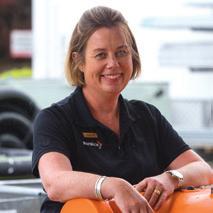
1. TELL US ABOUT YOUR CAREER JOURNEY WITH RURALCO
My journey with Ruralco started back in 1999 when I returned from my OE. Being born and raised on a sheep and beef farm in Oamaru, followed by veterinary nursing in Oamaru and Christchurch set me up well for Ruralco, and initially I worked in the Ashburton back shop. In 2001 I was privileged to be the first store manager of our store at Rakaia. The premises was the old jam factory in Rakaia. It was a new challenge for the business and for me personally, and it was here I developed a real passion for working with our customers. In 2004 I left to start our family, returning in 2018 to take up a role in the Ashburton Inwards Goods department—although I did come back from time to time over the years, filling in and helping at stocktake times. Last year I moved to the Ashburton back shop with animal health and groceries being my core responsibilities. In a way, I have come a full circle.
2. WHAT ENCOURAGES YOU TO CONTINUE WORKING FOR RURALCO?
I wanted to return to Ruralco and reconnect with my work mates and our customers— throughout my time at Ruralco I have made many lifelong friendships and I am proud of the history of our co-op which I have supported for many years. The flexibility of work hours was a real attraction when I returned, as I still needed time to parent and taxi my three children around and to help out on our arable, lamb and beef fattening farm at Barrhill. While I really enjoyed the accommodating hours and challenges of working in Inwards Goods, I missed working with the public and I’m loving being back in the Ashburton back shop.
3. HOW HAS RURALCO SUPPORTED YOUR CAREER PROGRESSION?
There are always opportunities to keep learning at Ruralco—so many new products continue to become available as well as regulation changes. It means we never stop learning. There are also plenty of opportunities to keep up to date with licences and operating certificates; to join internal committees which give great insights into other parts of the business; and to be part of project work. One such opportunity was the development of the website during Covid when it became a priority for the business to adapt and develop ways to connect with our customers, even during lockdowns. Having the ability to contribute from a hands-on perspective was really good, especially as it led to significant internal changes for Inwards Goods.
4. WHAT’S YOUR FAVOURITE PART OF YOUR JOB?
People are my passion so being immersed within the farming community, both at home and at work, has helped with my career choice and is very rewarding. Problem solving is also really fun. My job satisfaction comes from providing great customer service and by going above and beyond expectations. It can be as simple as having stock available especially at the moment when there are supply chain issues affecting many product lines—a lot of work goes into that. Having a farming background helps and I also try and keep up with all agricultural sectors, not just what we do at home. It’s about having empathy and understanding of all farming enterprises. I really enjoy personalising any customer service by finding a connection or mutual ground.
THIS IS A FAMILY RECIPE WHICH IS A LITTLE BIT DIFFERENT BUT IS ALWAYS POPULAR.
INGREDIENTS:
1 bottle of cream, whipped
1 small tin of crushed pineapple (well drained)
1 packet of butterscotch instant pudding

2 crushed Crunchie bars
10 brandy baskets (see recipe below)
Mint to garnish
METHOD:
Fold all ingredients together, and place equal amounts into brandy snap baskets. Garnish with fresh mint
INGREDIENTS:
2 tablespoons golden syrup
60 grams butter
1/3 cup lightly packed brown sugar
1/3 cup plain flour
2 teaspoons ground ginger
1 pinch salt
METHOD:
1. Preheat oven to 180ºC. Grease oven trays.
2. In a small saucepan, stir syrup, butter, and brown sugar over low heat until the butter has melted.
3. Remove from heat, stir in sifted flour, ginger, and salt until mixed well.
4. Drop rounded teaspoonfuls of mixture onto oven trays, allowing room for spreading (about two per tray).
5.
The Ruralco Way to me is all about going the extra mile to form trusting relationships with our extended Ruralco family. It’s about the people—connecting, understanding, and building rapport with staff and customers and being a team player. It’s about getting to know our people and their needs and it’s about having empathy with understanding. If we understand our people, we are then in a better position to meet their needs in all aspects of their business. Through problem solving, we can exceed their expectations and if we understand what they are trying to achieve, then we can help expand their thinking around available solutions.
5. For easy handling bake one tray at a time.
6. Bake snaps for six minutes or until they bubble and are golden brown.
7. Stand for one minute.
8. Using a thin metal spatula or knife, are fully loosen snaps from tray.
9. Working quickly, over a small, upturned mould or glass, shape snaps into baskets.
10. Transfer to a wire rack to cool.
11. Repeat with remaining snaps.

 WORDS BY ANITA BODY, IMAGES BY BILL CABOUT
WORDS BY ANITA BODY, IMAGES BY BILL CABOUT
REALISTIC EMERGENCY TRAINING OPPORTUNITIES PROVIDE VALUABLE FAMILIARISATION AND INSIGHTS FOR BOTH THE HOST AND FIRST RESPONDERS ACCORDING TO PARTICIPANTS IN A RECENT TRAINING EXERCISE HELD AT RURALCO’S ASHBURTON PREMISES.


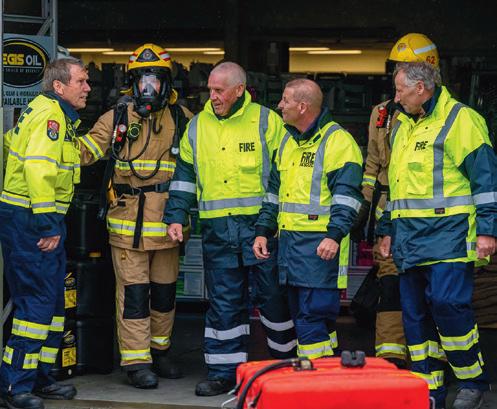
It’s not the first time Ruralco has hosted such an event, with Ruralco’s Compliance Manager, Peter Jacob saying it’s a great way to support local emergency services, while also ensuring they have first-hand knowledge of the building and the goods stored onsite should an incident ever occur.
“We help with setting up the various scenarios and it’s useful to see if there are any ways we can improve access or communication issues, or just support the teams on site,” he says. “We already supply the Fire Service with a manifest every six months which outlines the chemical and hazardous goods stored on site, building layouts, risk assessments and other relevant information. So, the training operation helps us see how a scenario might play out.”
The most recent training event was an interagency operation with both the Fire Service and St John attending. Previous events at Ruralco have also included the hazardous materials unit from Timaru.

Ashburton’s Chief Fire Officer, Alan Burgess says it’s a really good opportunity to put skills and knowledge into practise. “There are few training opportunities where you have a premises with such a diverse range of products stored in it, especially chemicals. It provides our people with familiarisation on both the building layouts and also what is stored on-site and the potential issues which could arise.”
While much of the exercise is planned, there are also variables which play out on the day such as weather conditions and the availability of personnel. Other benefits include the opportunity to communicate with the building occupants and other responders, to determine how different people can be utilised on the job, and to practise and review general command and control processes. “It’s good to see how other agencies work and to be able to recognise how outside factors might affect our processes.”
“We try to have one on-site training opportunity each year at various locations. They take a bit to organise but are well worth it. Re-visiting sites such as Ruralco are also valuable because it helps us stay familiar with any changes around chemicals, staff, and buildings, so we will definitely be back.”

Sunday, 2 April is time to put the clocks back for the end of daylight savings and it’s also time to check your smoke alarms as well as other potential fire hazards around the home ahead of winter. Smoke alarms do save lives. Fire and Emergency New Zealand states that one third (33%) of the residential fires attended last year did not have smoke alarms installed.
It’s also a good time to clear your driveway of low branches and other obstructions so that emergency services can access your property should a fire occur. Rural properties are more likely to use wood fires and the damage caused can be worse due to the extra time it takes for emergency services to arrive, so prevention is key.
Even after a fire is out, the ashes can stay warm for up to five days and can reignite. Place the ashes in a steel bucket and soak them in water until cool. It’s important to ensure the
bucket is stored in an open and safe place away from the house, decking, or garden area.

It’s also important to inspect your fireplaces and chimneys for deterioration and get your flue swept annually. Chimney fires can spread into ceilings and walls causing extensive damage to your house. If you’re concerned, ask a certified expert to inspect your fireplace and chimney for deterioration.
Make sure you have a fireguard to prevent sparks and embers from starting a fire on nearby rugs and carpets.
1 IN 6 HOUSE FIRE CLAIMS ARE CAUSED BY FIRES OR FIREPLACES
To learn more about the causes of house fires and advice on how to reduce fire risks, check out FMG’s House Fires Advice Guide at www.fmg.co.nz/advice/house-fires or head to Fire and Emergency New Zealand’s website www.fireandemergency.nz


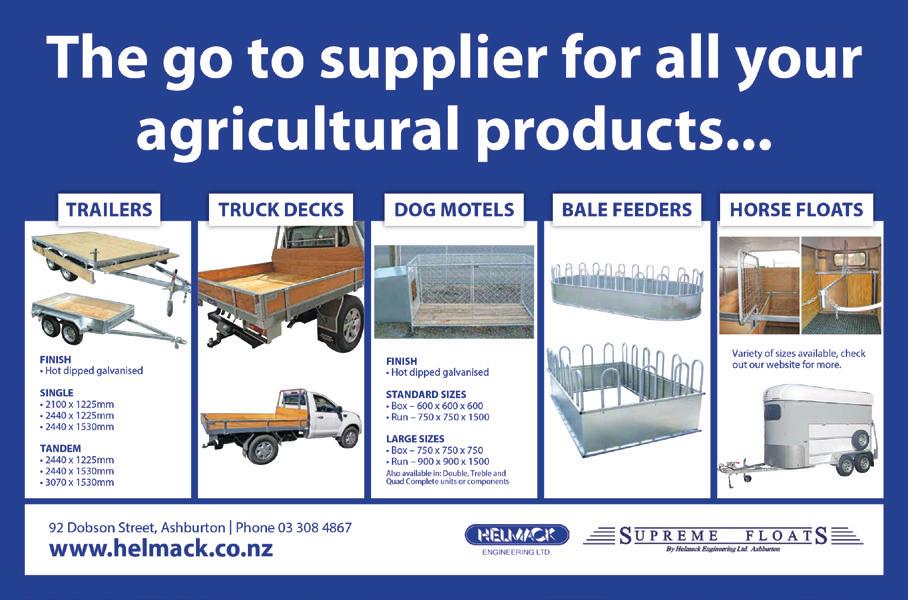


Time invested in preparing both ewes and rams for mating will help maximise lambing percentages and ultimately, next season’s lamb crop. WORDS AND IMAGES SUPPLIED BY BEEF + LAMB NEW ZEALAND
Mineral or trace element deficiencies should be addressed in the lead up to mating and Faecal Egg Counts carried out, particularly in younger sheep or older ewes that are under feed pressure.
Monitoring will allow farmers to have an evidence-based discussion with their animal health advisor about their drenching programme. For farmers using teaser rams timing is critical. There should be exactly 17 days between when the teaser ram goes out and when the entire ram is introduced.
Before rams are set to work, they should be checked for soundness, Brucella ovis and other sexually transmitted diseases and consideration given to wool length and the risk of flystrike. If ewes are to be shorn prior to mating, this should be done at least, but preferably more than three weeks prior to ram introduction.
Ram harnesses can be a usual tool to identify the timing of ewes mated and the spread of lambing. Harnesses can help save valuable feed resources as mated ewes can be drafted out and put onto maintenance feed, freeing up feed for unmated ewes and other stock classes.
Going into mating, sheep farmers need to consider a number of factors including mating date(s), the use of teaser rams, the health of their ram team, ram ratios, the use of ram harnesses, pre-mating management of their ewes and whether or not hogget mating will be an option this year.
Ewe body condition score before and during mating is a key driver of success. Scientists estimate lambing percentages increase by 6–10 per cent for every extra unit of body condition score at mating.
While most farmers are aware of this, it is difficult to accurately judge the condition of woolly ewes by eye.
Body condition scoring is the fastest and most accurate way of measuring ewe condition and is done by feeling the vertical (spine) and horizontal (lumbar) processes along the loin area.
Ideally, each ewe should be at a Body Condition Score of 3 or4 at mating where the vertical and horizontal processes are smooth and rounded and bone is only felt with pressure. The loin muscle is full with moderate fat cover.
Ewes should be going into mating on at least a flat—and preferably rising—plane of nutrition. In a year where feed resources are tight, farmers might consider using a brassica crop or grain to lift or maintain body condition.
Ideally grain should be fed in the 10 days before and 10 days after mating and allocation should be based on the quantity and quality of the pasture or forage the ewes are eating. Over mating, 55kg ewes should have an intake of at least 11 to 11.5 MJME/day of high-quality green pasture and for 65kg ewes, this increases to 12.5 to 13.0 MJ ME/day.
This is provided by at least 1-1.2kg of high-quality green pasture every day. This means that over mating, the ewe flock should be rotated rapidly onto pasture that is 5-6cm high. Grazing below 3cm (or 1,500kg DM/ha) will result in loss of body condition and lower lambing percentages.
Hogget mating should be a seasonal decision and farmers need to carefully consider whether they mate all, a proportion or none of their hoggets given the season and possibility of tight feed resources.
It’s not just about getting them in lamb, it’s about ensuring they are well-grown out when they lamb in the spring and when they go to the ram as two-tooths.
Hoggets to be mated should be selected on a minimum weight (eg only those 42kg and over), not a mob average (eg average 44kg, as a significant proportion will be below 40kg).
FOR MORE INFORMATION ON MANAGING EWES AT MATING GO TO B+LNZ’S KNOWLEDGE HUB

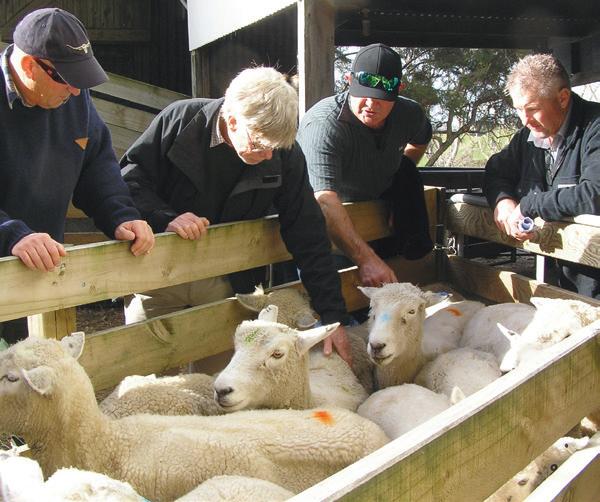





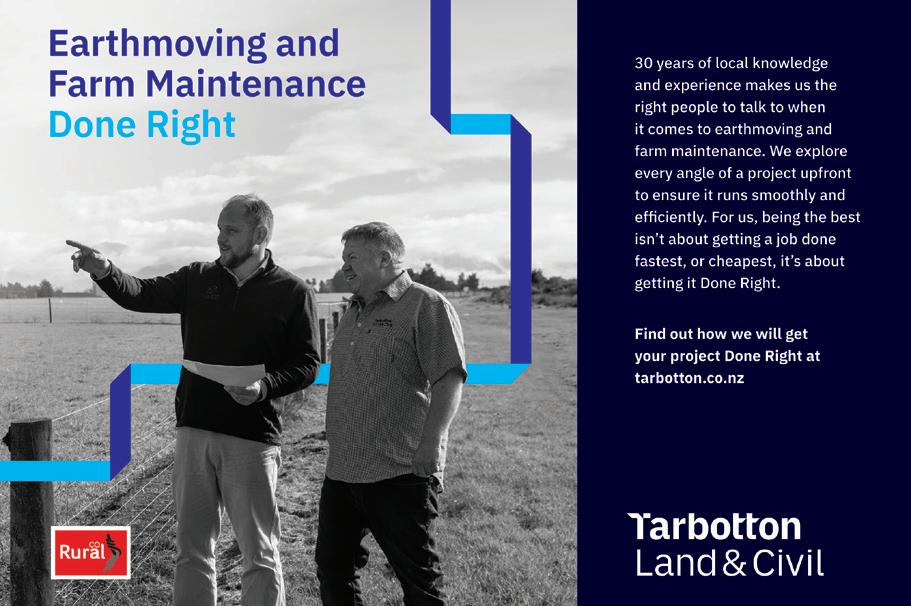

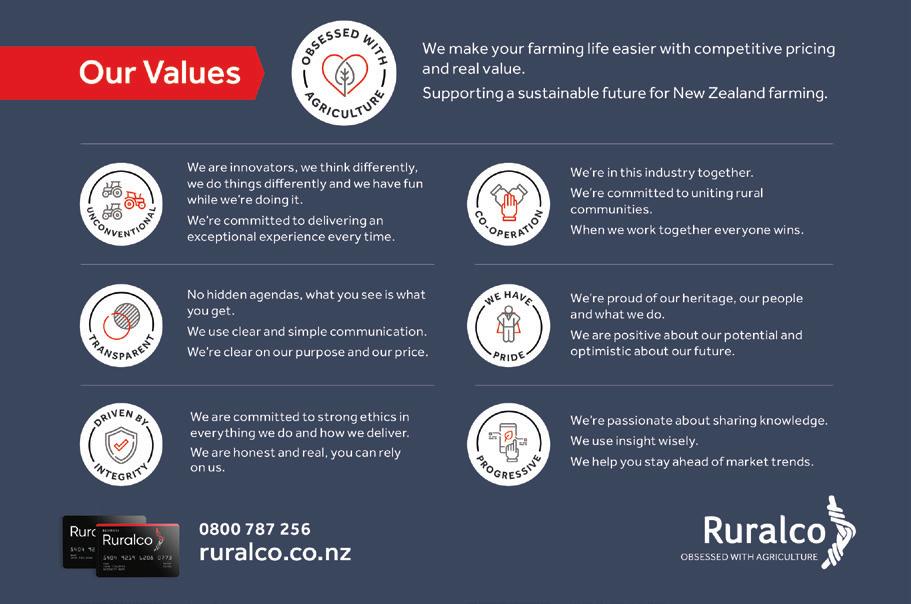
Just after Christmas, New Zealand— the land of plenty, with plenty enjoying many a festive meal—ran out of eggs. This wasn’t caused by Covid-19, supply chains or the weather, which have been behind other recent perishable food shortages and price rises. Remember when McDonald’s ran out of lettuce, when restrictions were eased after our country’s first national lockdown in late April 2020?
WORDS SUPPLIED BY NADINE TUNLEY, HORTNZ CHIEF EXECUTIVENo, behind New Zealand’s egg shortage is egg producers’ response to regulation that wasn’t fit for purpose, was changed mid-stream, resulting in unrealistic timeframes and the undermining of confidence.
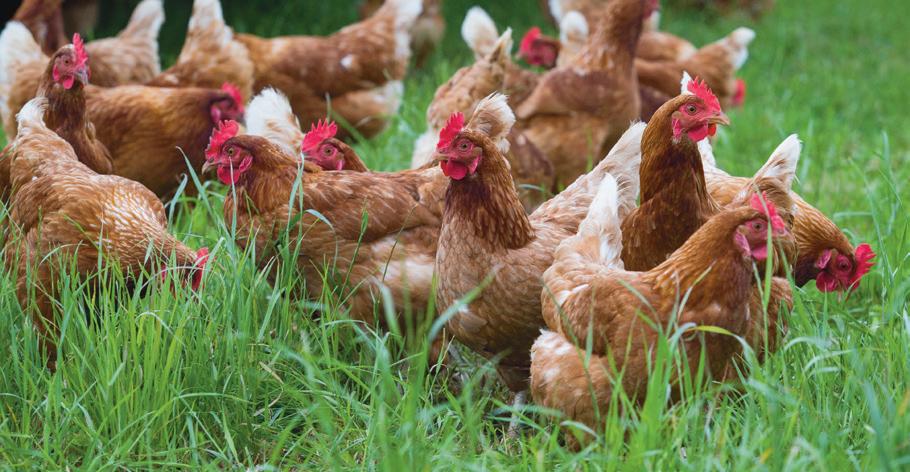
Do not get me wrong, improving the welfare of chickens and all animals is a good thing, just like reducing environmental impact and improving freshwater quality are good things.
The point I am making here is the very real and immediate effect of poor regulation and the domino effect on food production, and the stark consumer impact, even in a land of plenty like New Zealand.
The Egg Producers’ Federation of New Zealand says in the year to June 2022, egg production
dropped by ten percent—back to 2016 levels— which was the biggest fall in egg production that New Zealand has seen in 20 years.
Why was this? The Egg Producers’ Federation says it was because of the number of producers exiting the industry, thanks to a lack of confidence due not only to the changes in regulation and the costs associated with that, but also due to inflation and increases in feed grain prices—feed being 65 to 70 percent of the cost of producing an egg. Sounds like a perfect storm, and also a situation not too dissimilar to the one that fruit and vegetable growers are facing. That is, poorly thought through and rushed regulation that is not co-ordinated across government, coupled with ever increasing production costs, the labour shortage and seemingly neverending weather that is not ideal for growing. What impact is this situation having? More and more growers are considering making the heartbreaking decision to leave the industry, because it is just too hard. Some growers have already made this decision and are selling up or just mothballing their operations.
What will the impact of this be on consumers?
I think we are already starting to see an impact, with less reliable vegetable supply and associated increased prices. While some in government seem to still believe that New Zealand could import its fresh vegetables,
in reality, logistically and economically, that is never going to work plus it would drastically reduce our already fragile food security. New Zealand is a land of plenty; we used to be proud of that. Now however, the food and fibre sector is fast drowning in uncoordinated, complex and unrealistic regulation. We know and accept we must do better, just like the egg producers knew and accepted that. However, the way the current government is going about change is not the way to do it, just after a pandemic when the world is still in social and economic turmoil.
This year, we hope the government is more open to listening, and takes more swift and practical action in the right places, particularly in the area of Resource Management Act (RMA) reform. There is too much riding on this reform to get it wrong—again. I say again as since the RMA was enacted in 1991, it has been amended more than 20 times creating uncertainty, inaction and unnecessary cost. That is just not the way to run a country, let alone a successful business. The only outcome of this approach is having egg on our faces. Reform of the RMA is the biggest policy change in 20 years and will affect the life of every New Zealander for at least 20 to 30 years—it is paramount it’s got right.
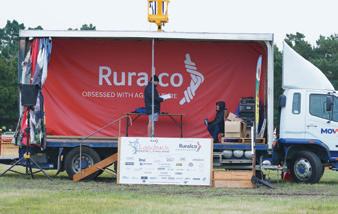






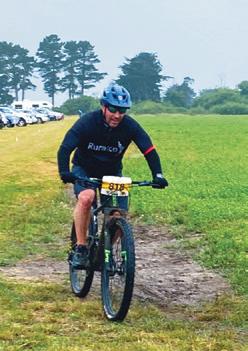

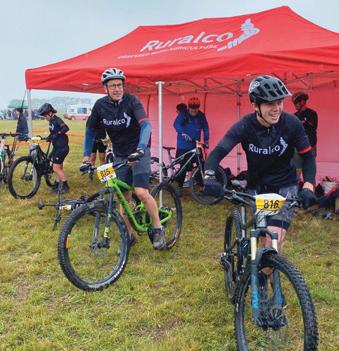
“That’s why piggeries are often sited on land considered highly productive. Two thirds of commercial pig farms in New Zealand are situated on land classified as highly productive under the NPS-HPL.”

The compounding factor is that pig farmers may shortly be under pressure to potentially double their building footprints to account for code of welfare changes. This combination of conflicting policies will severely restrict many farmers ability to do so. Many will likely leave the industry as a result.
Karl says they would need to build five new indoor sheds to meet the welfare code changes.
“It’s already hard enough with the regulatory hoops we need to jump through with simple things like building sheds. Our system is worldclass, yet issues arise, and costs can build up.
“Now, with the NPS-HPL adding another layer of complexity for no good reason, we’d have to significantly reduce our pig numbers, making a lot of people unemployed and effectively making our operation economically unviable. We’d have no choice but to disappear.
“Farmers rely on us for food security to make milk year-round. If we’re not here they have to grow their own feed, piling on artificial fertiliser upping their costs and nutrient loading the land.”
Switching from a 70-year tradition of dairy farming to expand their piggery and cropping operations has paid off for the Stanley family, the environment and the local farming community.
The award-winning 131ha Stanley Brothers farm at Oaonui near Opunake in Taranaki produces 11,500 pigs a year, feeding up to 40,000 people a year.
All the effluent produced in the indoor piggery is irrigated onto the land as a rich natural fertiliser to grow and sell high quality feed crops to local dairy farmers.
“We haven’t used synthetic fertilisers for over two decades and are now averaging about 24 tonnes per hectare of dry matter annually and around 900 bales of hay per season and 800 bales of haylage, all to be sold off locally,” says Karl Stanley.
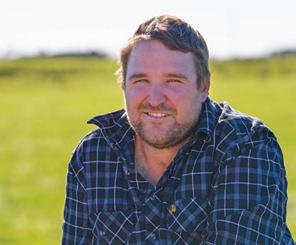
“It’s the ultimate circular economy. Our pigs work for the land, the land works for the pigs and we produce high-quality food. If we don’t have pigs, we don’t arable farm.”
Indoor pig farming is an intensive primary production activity that requires access to arable land.
Yet under the Government’s new National Policy Statement (NPS) on Highly Productive Land (HPL), the Stanley Brothers farm – and many others like it - is threatened.
The NPS-HPL is intended to enhance protection for highly productive land from inappropriate subdivision, use, and development. However, it classifies indoor pig farming as an ‘inappropriate land use’ as they are deemed to not directly rely on the soil-resource of the land.
“From our point of view, it doesn’t make sense. The Government has clearly no knowledge of how our systems work.”
NZPork Senior Environmental Advisor Hannah Ritche says no analysis has been provided on how the decision was made.
“We’ve also seen little evaluation of the environmental, economic or social impacts of excluding indoor pig farming from operating on highly productive land.
“The fact is that pig farming is more than just the buildings. Every single piggery needs an effluent discharge field and that is why piggeries operate in a rural environment, incorporating either a pastoral or arable operation. Effluent from the piggery is applied to the arable or pastoral land as a natural fertiliser. The land can, in turn, grow feed for the pigs and local community. The two cannot be separated.
Hannah says NZPork will continue to pressure the Government to make changes.
“We would like to see indoor pig farming reclassified as an acceptable activity on highly productive land. Making this change would not contradict the intent of the policy—to protect highly productive land for food and fibre production. Not making this change could be incredibly damaging to the New Zealand pork industry.”
ABOVE: Indoor farm where sows spend a limited amount of time caring for their piglets
BELOW: Karl Stanley of the award-winning 131ha Stanley Brothers farm at Oaonui near Opunake
11 MARCH
Join us at the Ruralco marquee for a BBQ, a chat with the team, and go in the draw to win an Autumn gift bundle and a $1,000 fuel credit.
18 MARCH
Join us at the Ruralco marquee for a BBQ, chat with the team, and go in the draw to win an Autumn gift bundle and a $1,000 fuel credit.
29, 30, 31 MARCH
Join us at the South Island Agricultural Field Days at the Ruralco marquee. We are showcasing the latest products and services on offer and have plenty of prizes up for grabs.
1. DO YOU KNOW WHERE YOUR RURALCO CARD IS?
If you can’t find your card, please let us know immediately.
2.
Check your transactions on your statements or in your online account and let us know straight away if there are any purchases that were not made by you or any other cardholders on your account. You will be responsible for all charges made on a Ruralco card up to the point that you notify us of anything suspicious. This includes any transactions made on cards that may have been given to family members or staff.
Your card security is very important, so always knowing where your card is and keeping an eye on your transactions will help you to pick up any unusual activity.
Through our partners Ruralco can design and implement a solar system for your business, enabling you to beat rising energy costs, offset emissions, and make better use of a natural resource to produce and store renewable energy. Not only can solar power be used for powering irrigators and dairy sheds—it can also be used to offset the cost of lighting, heating and ventilation in farm buildings and homes.
Talk to the Ruralco team today on 0800 787 256 to find out how we can help introduce solar to your business.

Join us in Kirwee at the South Island Agricultural Field Days at the end of March. Visit our site for a coffee, a chat and learn about our latest products and services. We have plenty of prizes to be won, too, including a Weber Genesis II BBQ with a BBQ toolset, and $300 Netherby Meats voucher; Yeti Cooler Bag and Swanndri Picnic Blanket; and a Cocky Overnight Bag!
Remember to bring your Ruralco card so you can make the most of the special offers from our card merchants. Look for the Ruralco signs and stickers to show you all the places your Ruralco card is accepted at the event.
Our partnership with Ballance Agri- Nutrients gives you access to local fertiliser experts that can tailor a solid fertiliser plan to maximise your on-farm production potential. Together we can bring you science-backed and innovative nutrient solutions that will maximise your on-farm production potential delivering a measurable return on investment. Make the switch to Ballance through Ruralco for all your fertiliser requirements. Talk to your Ruralco Representative today.

We’ve got the whole family covered this winter with our wide range of clothing and footwear. Come into our Ashburton, Methven or Rakaia stores to find your perfect fit or order online with free delivery nationwide*.Choose from our range of high-quality brands to stand the test of time. Check out the new season range in the 2023 catalogue, in letterboxes now.
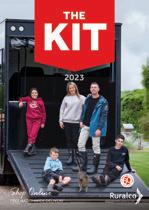
Visit our website to find out more: www.ruralco.co.nz/thekit
*T&C’s apply
Our Boost Mineral Blend is a specifically formulated water-soluble, multi-mineral blend providing essential trace elements for animal health. We can also customise the mix to suit your dairy herd’s requirements, delivering it direct to farm.
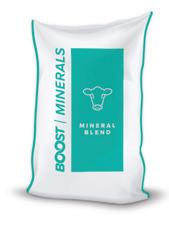
• Suitable supplement for your livestock requirements.
• Easily dissolved via addition to drinking water through a mineral dispenser.
• Flavoured with aniseed for improved palatability.
• Can be packaged as convenient individual day packs for the whole herd or as a bulk bag for self-measuring.
• Active ingredients are subject to herd requirements but can include trace elements, minerals and vitamins, and other additives that may be required. Talk to your Ruralco representative today to discuss the best mineral mix for your livestock or find out more online at www.ruralco.co.nz/boost.
Animal Health Guide 2023 out now
Our extensive product range will help you maximise production and ensure the health of your animals. Check out the latest Ruralco Animal Health Guide in letterboxes now or at www.ruralco.co.nz/animalhealth

Now’s a good time to check to see if your approved handler certification is up for renewal, or if you have new staff who need to gain certification to handle hazardous substances on your farm. Ruralco can help put you in touch with the organisations to help meet your approved handler needs. Contact the Ruralco Customer Service Centre or Compliance Manager, Peter Jacob on 0800 787 256 to find out more.
EV stations available at Ashburton store

Ruralco and Meridian have joined forces to provide an electric charging station on the Burnett Street side of Ruralco Ashburton store. The EV charging station has four charging points via two charging stations and the 22kW AC chargers are currently free to use. Here at Ruralco we care about the environment and the wider benefits for our community, and we are always looking towards the future to provide benefits for our members.
Ruralco’s Pasture Packs provide you with the right mix necessary to produce ultimate results and ultimate pastures. Grab a copy of the guide today from the Ruralco team or visit www.ruralco.co.nz/ pasturepacks for more information.


This is just a snapshot of the many great businesses where you can use your Ruralco card and save. Visit www.ruralco.co.nz for a full list of participating businesses near you and discounts available.
NORTH ISLAND
Auckland Beds R Us Pukekohe
Up to 20% discount
Plumbing World (Onehunga, Kumeu, Kingsland)
Up to 30% discount
Waikato
Plumbing World Turangi
Up to 30% discount
Northland
Plumbing World Bream Bay
Up to 30% discount
Wellington-Wairarapa
Plumbing World Kilbirnie
Up to 30% discount
Mobil Porirua
12¢ per litre
SOUTH ISLAND
Central Canterbury
Canterbury Vehicle Compliance Belfast
Up to 7% discount
Weldworx Industrial Supplies
15% discount
Jump Charging Quoted pricing
Serial Chillers
7% discount
Mid Canterbury
Ash Auto Tech
Up to 10% Discount
Allenton Auto Centre
5% Discount Parts & Labour
South Canterbury
Stowell Motor Repairs
5% discount
Central Otago
APL Fuelstop Makarora
12¢ per litre
Plumbing World Cromwell
Up to 30% discount
New World Balclutha Convenience
We’re working for you this dairy season and offering competitive pricing with real value on products to maximise your production on farm. Check out the latest guide in letterboxes now or at www.ruralco. co.nz/dairy.
